CUSTOM TERRY
I named my custom Lego train
setup TERRY
, which
stands for Terry Ericksons
Rail Road Yard
. This is
my Lego based train yard
layout with many train
related items as well as a
few extra things. This has
a mixture of passenger and
freight train features.
Note:
This project is now ready
to display. The images on
this page were taken as
the progress was going on.
I will post the ACTUAL
DISPLAY photo once it is
setup in early November
2018.
| UPDATES | |
|---|---|
| DATE | DESCRIPTION |
| 11/09/2018 | Made some minor changes to page text |
| 11/05/2018 | Added Updated photo of actual display |
| 11/03/2018-11/04/2018 | Displayed at Roselle Public Library |
| 11/02/2018 | Disassemble and transport for setup |
| 11/01/2018 |
Full layout image updated, final version
Some detail added to items Finished Bank/laundry building image added |
| 10/30/2018 | Most of Bank/laundry building text and image added |
| 10/26/2018 |
Tree text and image added
Delay ahead expected in building due to obligations |
| 10/21/2018 |
Tunnel text and image added
Workshop image and text updated Track layout image updated |
| 10/17/2018 |
Tower text updated and image added
Crossing guard image and text updated Train station image and text updated Track layout image updated |
| 10/16/2018 |
Log car image updated
Book car image and text added Rock car image and text updated Refrigerated car image and text added Livestock car image and text added Trees car image and text added Glass jar car image and text added Container car image and text added Fenced car image removed Snack shop image and text added Removed second siding and track Better defined sections of webpage Freight cars now listed alphabetically Structures now listed as displayed left to right |
| 10/10/2018 |
Moved track layout to table
Track layout image updated Lego car image updated Fenced car image updated |
| 10/09/2018 |
Loading dock image and text added
Lego/rock/fenced cars image and text added |
| 10/03/2018 | Sorting Lego parts order |
| 09/27/2018 |
Track layout image updated
Coal car (alone) image updated Water tank car image updated Water tower image and text added Workshop image and text added Crossing guard image and text added Washroom image and text added |
| 09/22/2018 |
Barrels car image and text updated
Boxcar image and text added Water tank car image and text added |
| 09/21/2018 |
Train station image and text added
Barrels car image and text added Auto transport car image and text added |
| 09/20/2018 |
Track layout image and text added
Engine image and text added Museum image and text added Log car image and text added Passenger cars image and text added Train at station image and text added |
| 09/19/2018 | Basic text added |
| 09/18/2018 | Page creation |
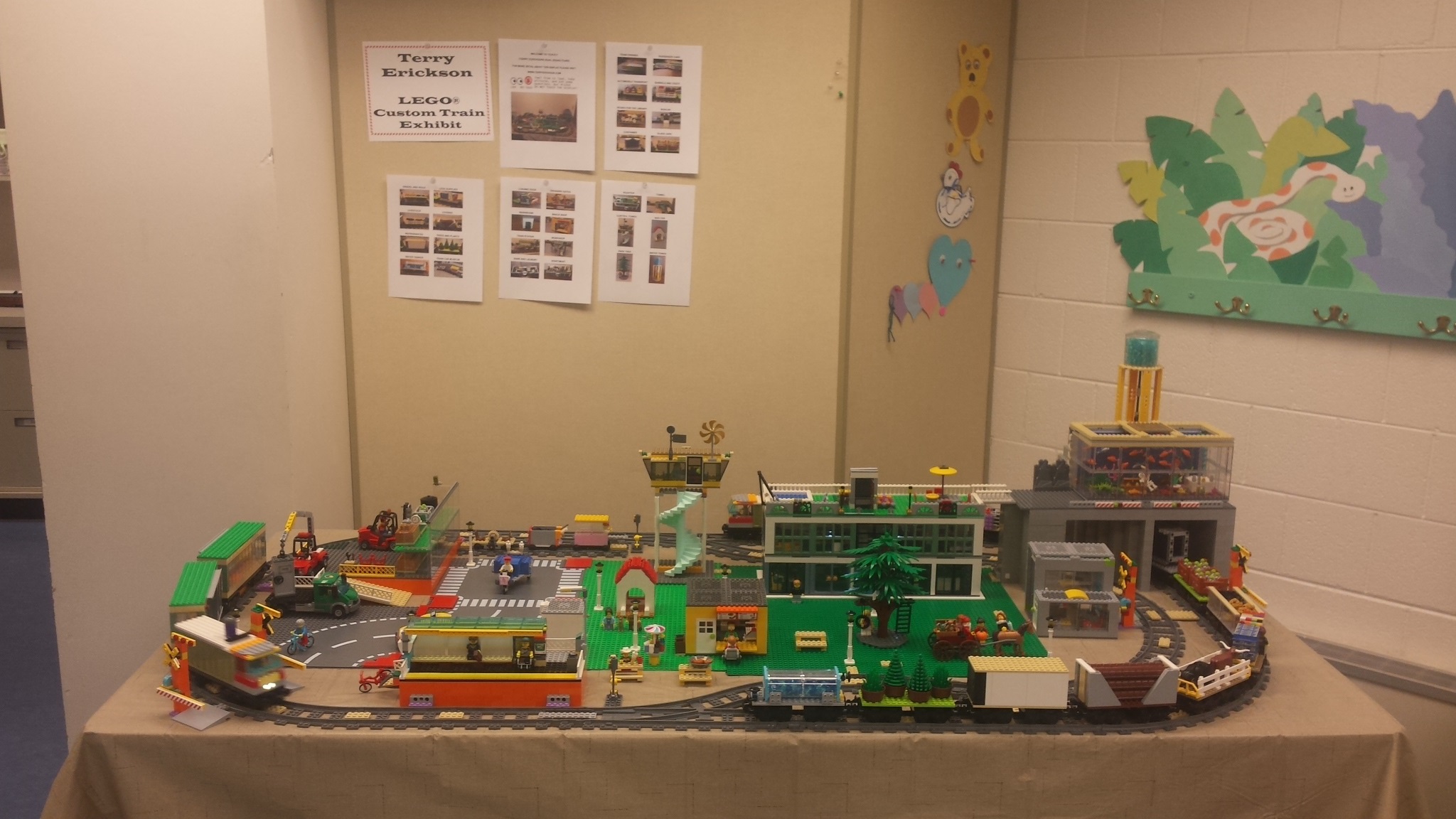
In anticipation of the 2018 Roselle Public Library Model Train Showcase, I have been working on a custom Lego train layout. This is something which I have wanted to do for a long time but now I have the motivation due to a display event.
The layout features a passenger train (engine and two cars), a freight train (engine and 13 cars), and a museum track (3 retired cars). There is also an assortment of train related buildings and scenery. The full track layout is just under 3 foot by 6 foot.
The layout is NOT to any particular scale of real trains. This is typical with Lego models. But I have designed this to be mostly realistic in the concept and beyond that added some imagination. All of the train cars have a similar base size and height, much like a real train does. However, the buildings are designed for Lego Minifigs and are therefore of a larger scale than the train cars.
The trains:
Engine:
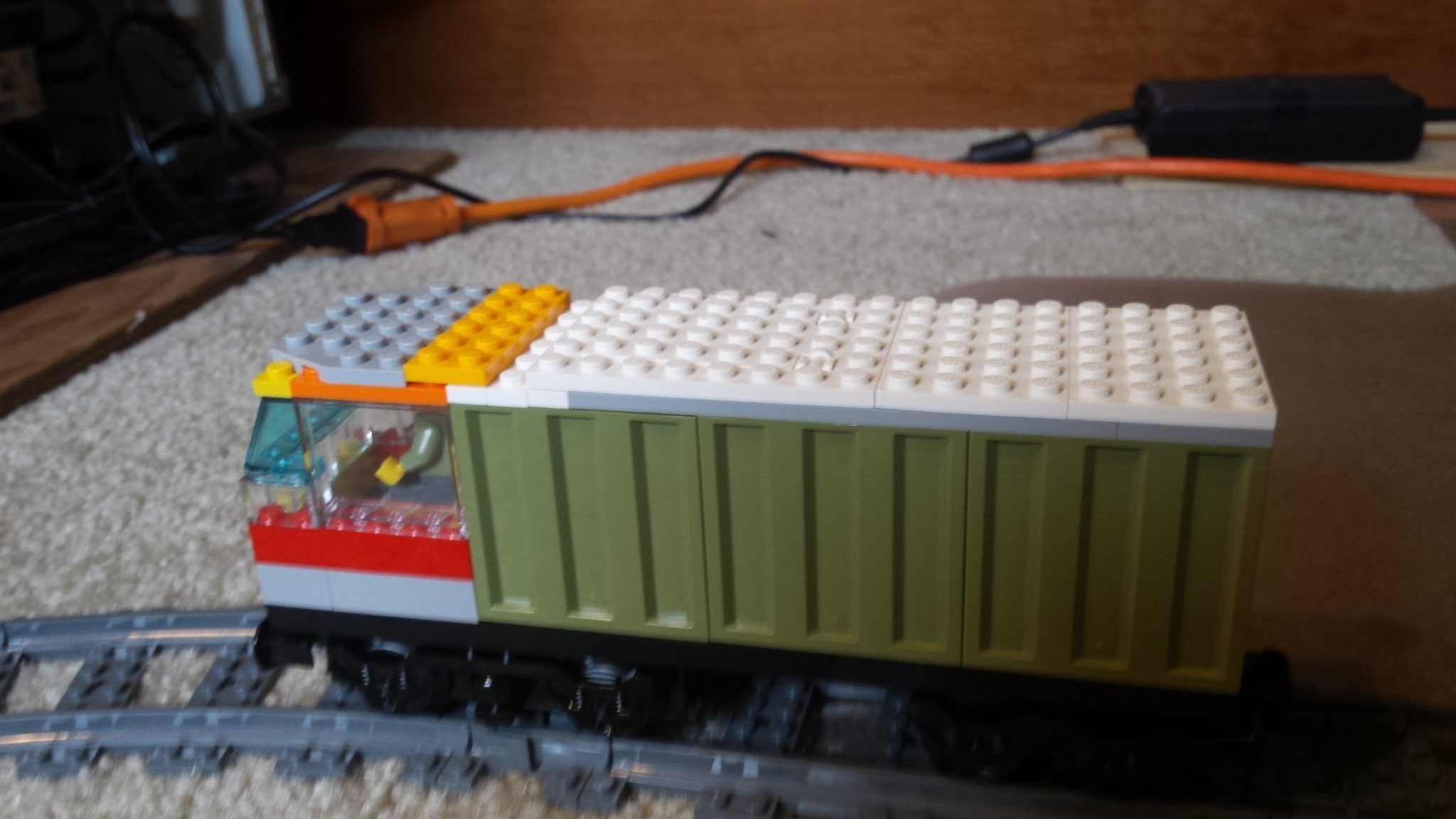
The two train engines are ALMOST identical, the only difference is the engineer.
The engines are as compact as I could get them. The motor is under the bed in the front. The battery, IR receiver, and wiring are all squeezed in the back portion. The lights are mounted at the front just above the bed. The cabin is in the front with lots of windows. The cabin is somewhat lighted by the front mounted lights also.
The top of the engine has a trap door which can be lifted to provide access to the battery, allowing it to be switched on and off or recharged without the need to take apart the engine.
The only planned changes for the engines are to add some decoration to the top and maybe decals to the sides.
Passenger cars:
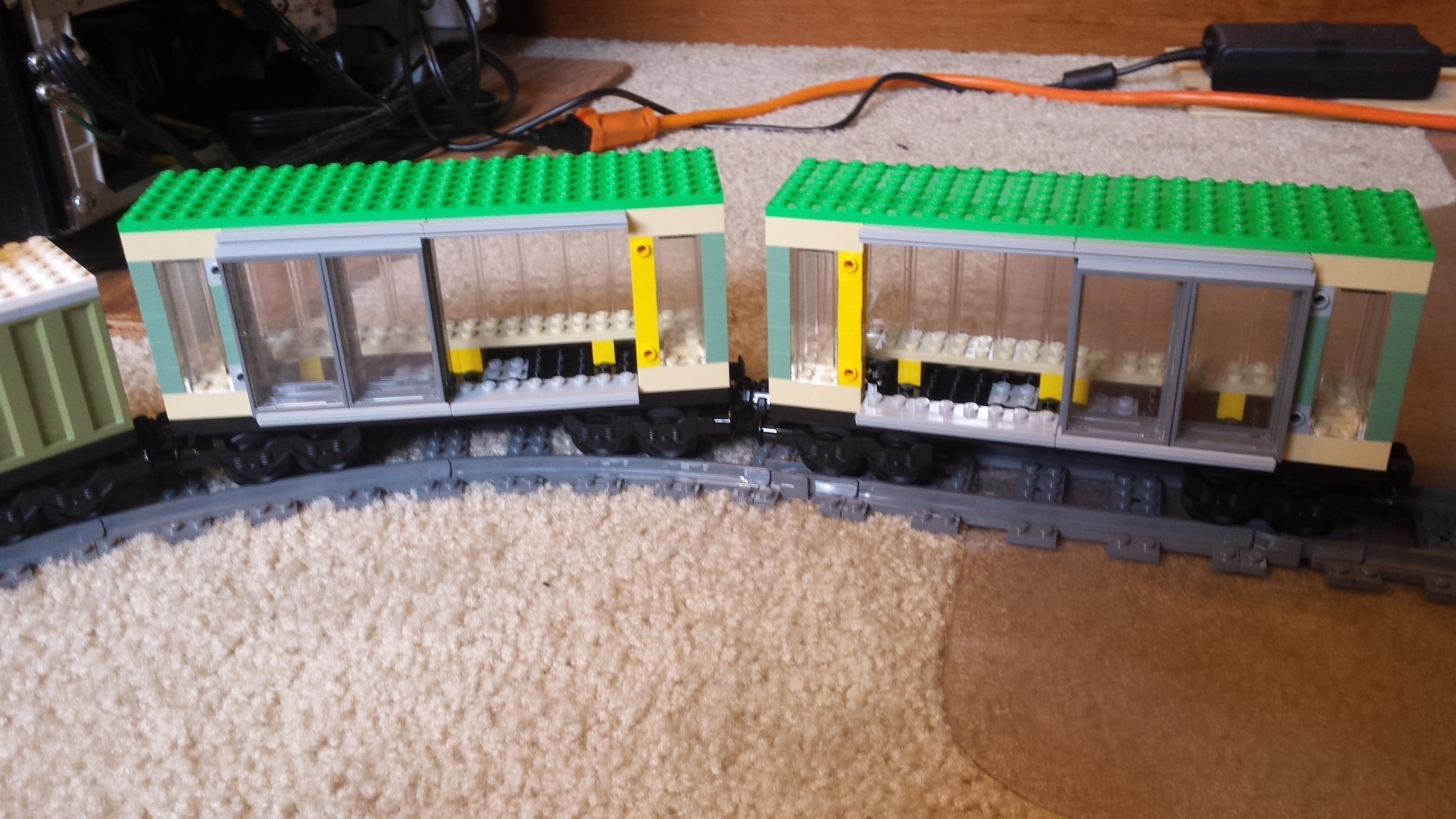
Each of the 2 passenger cars can have 6 minifigs seated and 4 standing. The cars feature sliding doors to allow for boarding. The doors are designed to slide in opposite directions so to provide a shorter length of platform needed at the train station.
These were originally built as double decker cars. But since these easily tipped over on curves, I took off the upper deck. Also, the height of the passenger cars now matches the freight cars.
The only planned modification
would be to add decoration to
the top of the cars and put
the indicator lights
(not actual lights, just pads)
on the posts by the doors.
Auto transport:
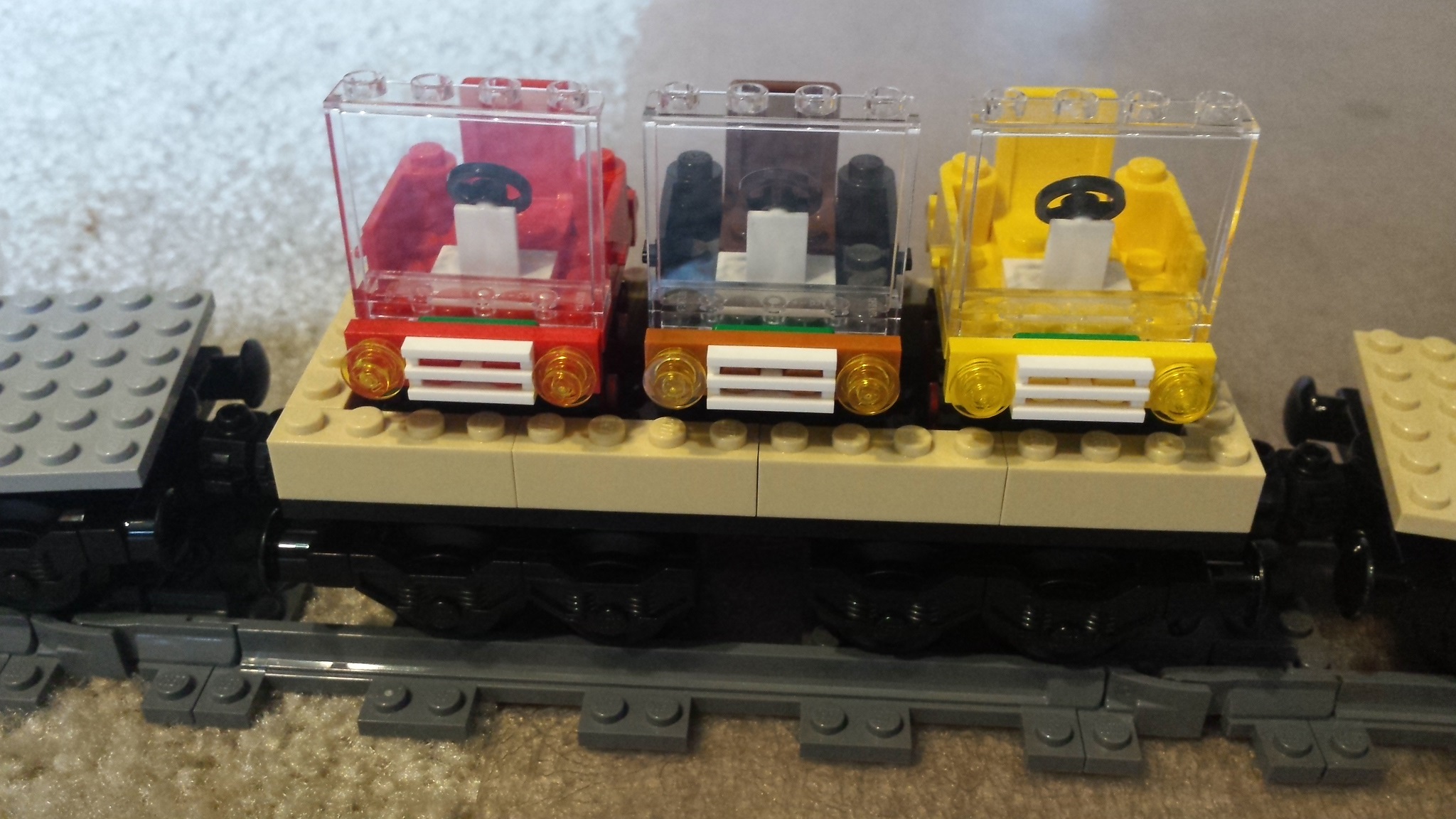
Each freight train car can transport several vehicles. The size of the vehicles and the size of the train car will determine the quantity of vehicles it can hold.
Sometimes vehicles are transported inside of an enclosure on the train car. This may be done to protect the vehicle or to hide it from view.
I have 3 small vehicles on my auto car. These are very compact models just to show how a vehicle can be transported by train.
Barrels car:
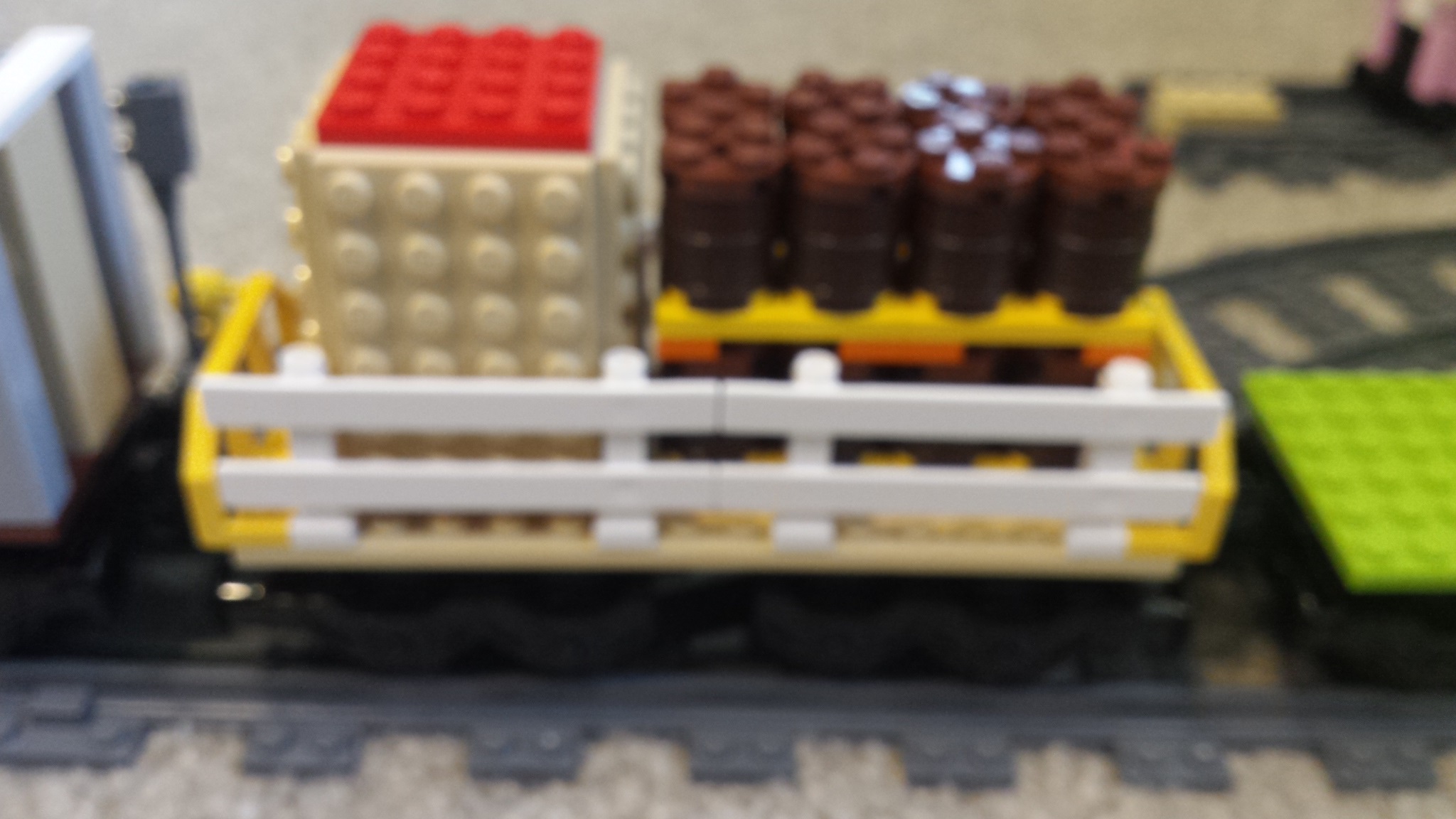
Barrels, crates, or large boxes can be used to store bulk items which do not have enough quantity to require a full size train car. Often these are transported inside of a boxcar, but larger sized containers often ride on a flatcar such as this.
Here the barrels are on pallets for easy transfer at the loading dock.
Book car:
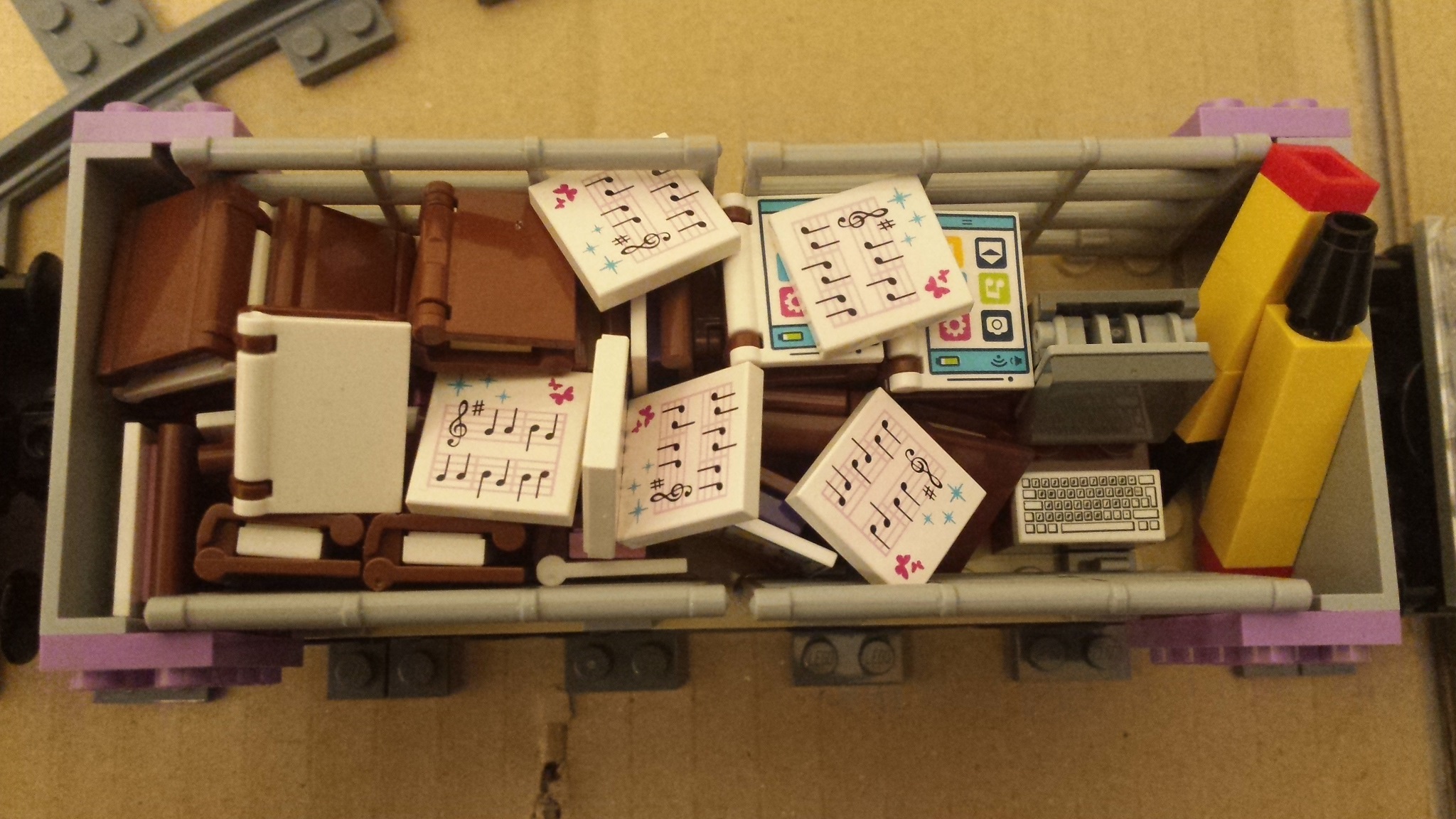
As a tribute to the Roselle Library (and libraries in general), I created a car which brings books, music, and other supplies to them.
This car has assorted books and music as well as a computer and pencils.
Boxcar:
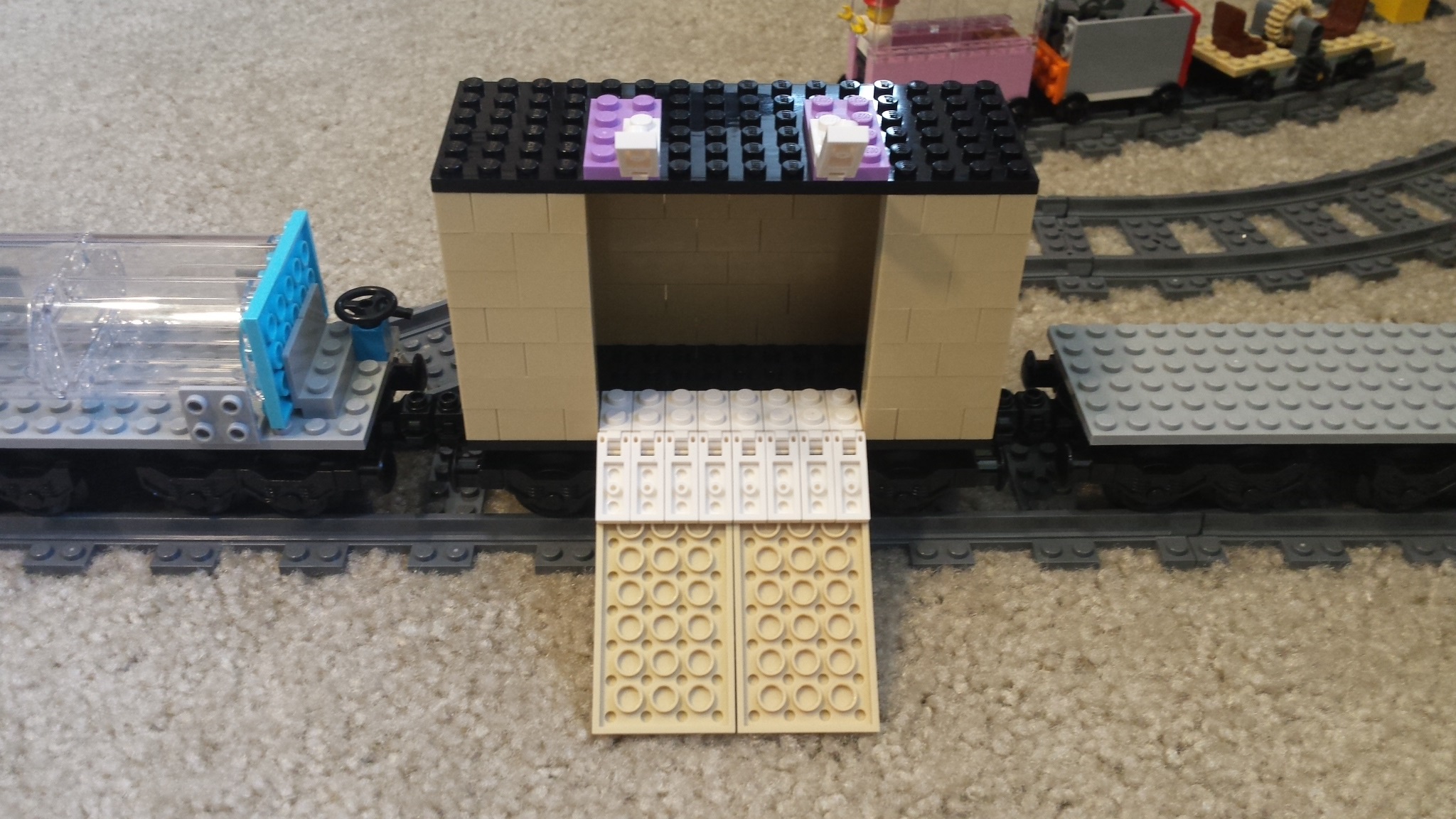
A boxcar on a railroad is similar to a truck on a highway. The car is shaped like a box which is how it got its name.
These have doors which allow cargo to be loaded or unloaded, usually on pallets. Commonly sliding doors are used which requires less room at a loading dock, but swing out or fold down types are other options.
My boxcar has doors which are on a hinge and drop down to form a ramp for access to the freight.
Container:

Cargo is often placed in large containers which are then loaded onto a flatbed train car. Use of the container means that the contents do not have to be transferred individually, which saves time during the loading process.
Containers usually have some type of hook system on them. Cranes can be used to load or unload the container from the car.
Glass jars:
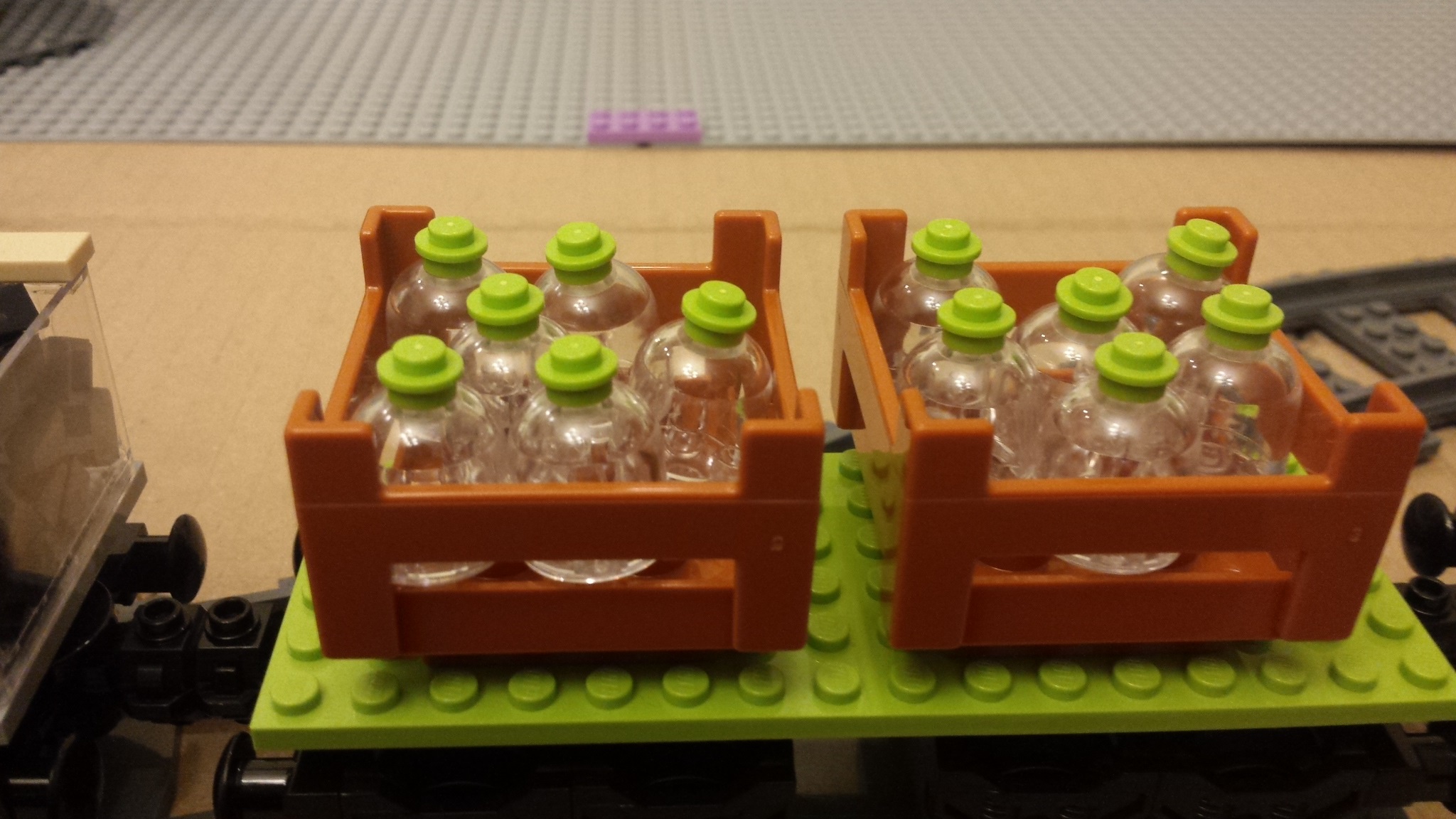
This is an example of how custom storage crates can be used to hold items on a freight train car. Odd shaped or fragile cargo will often be transported in custom containers.
Gravel/rock car:
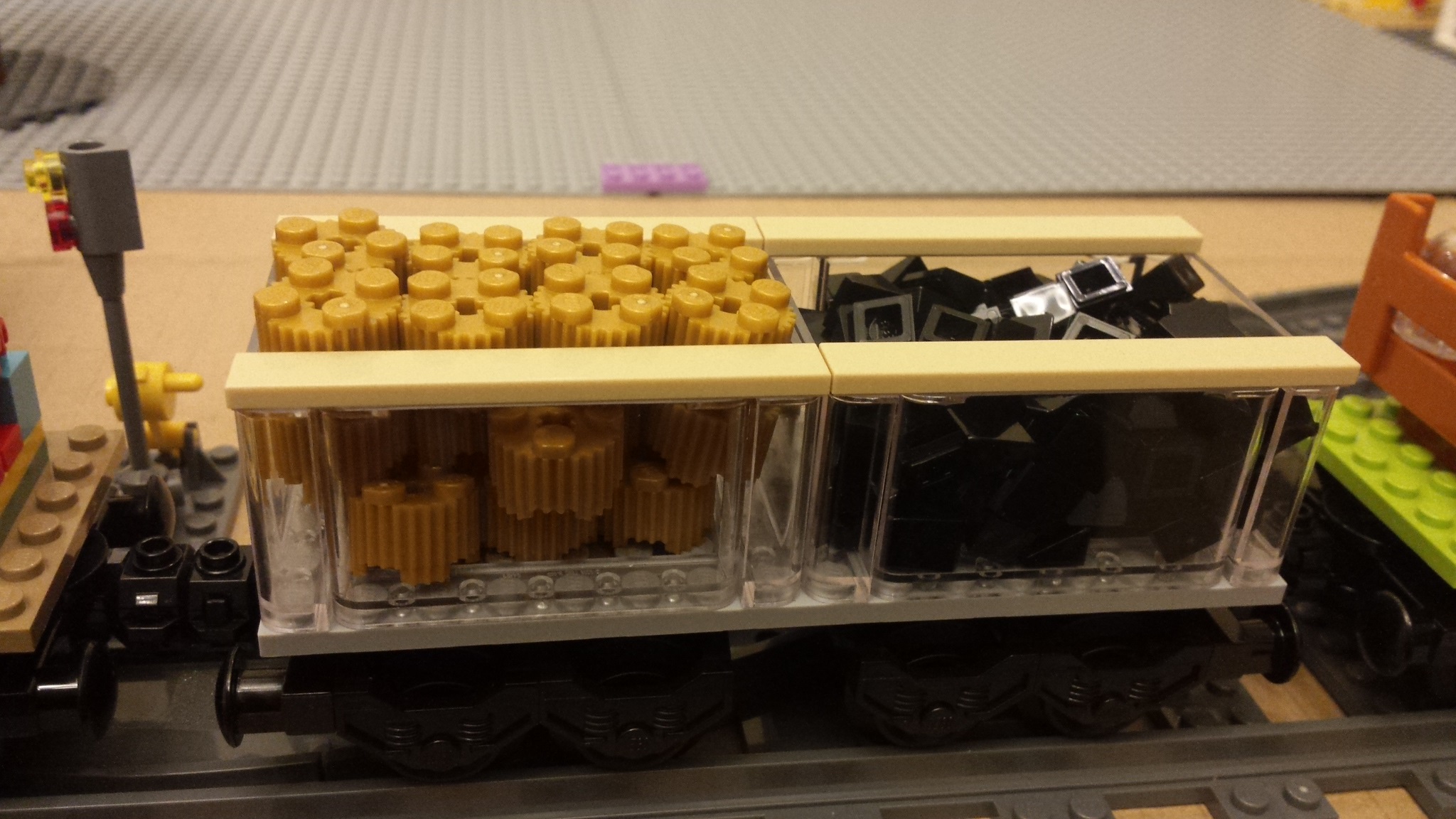
The railway is an efficient method to haul heavy loads over a great distance. It is common for trains to move rocks, dirt, salt, coal, gravel, and other heavy material.
My rock car has two types of rocks in it, large gold rocks and small black rocks.
Lego car:
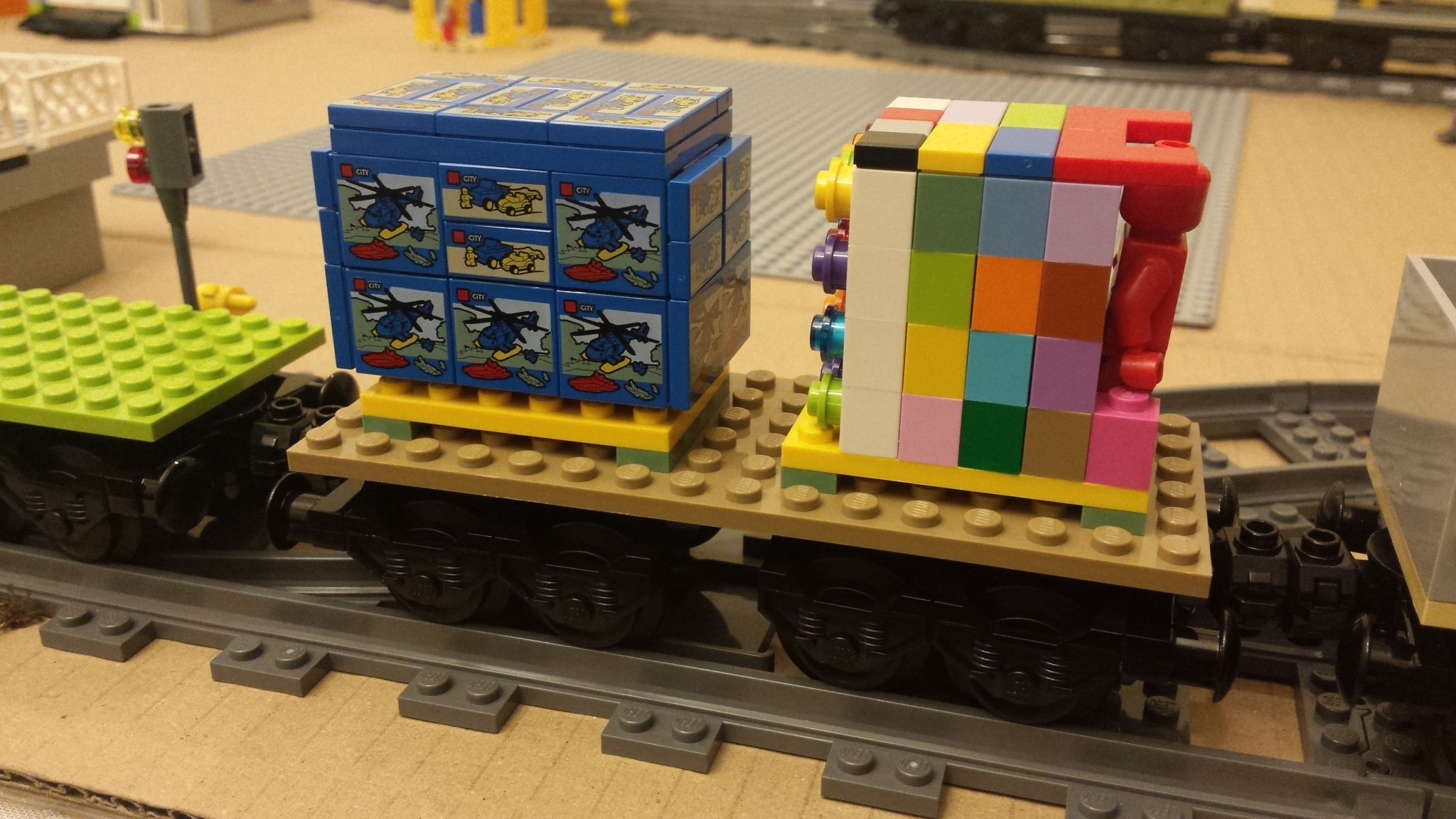
It is fitting to have a Lego train transporting sets and bricks to your nearby Lego store.
Although this type of thing would normally be inside of a boxcar, I built my Lego car so the items would be visible. One pallet has Lego sets and the other has Lego bricks and minifigs.
Livestock:
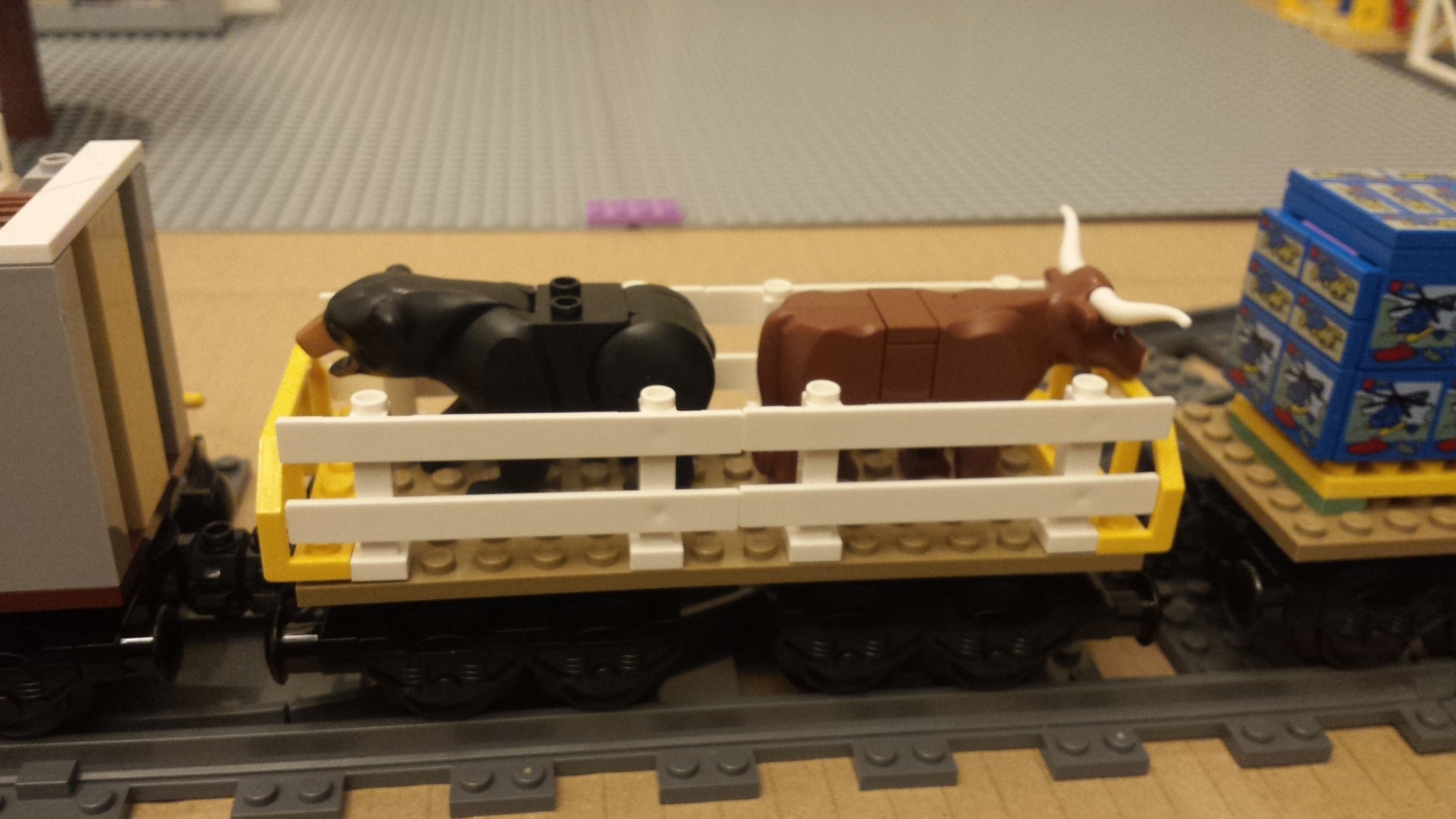
Trains can even carry livestock such as cows, horses, pigs, and chickens. Here a cow and bear are going to a zoo.
Livestock cars are far more enclosed then my version to prevent the animals from getting out.
Logging car:
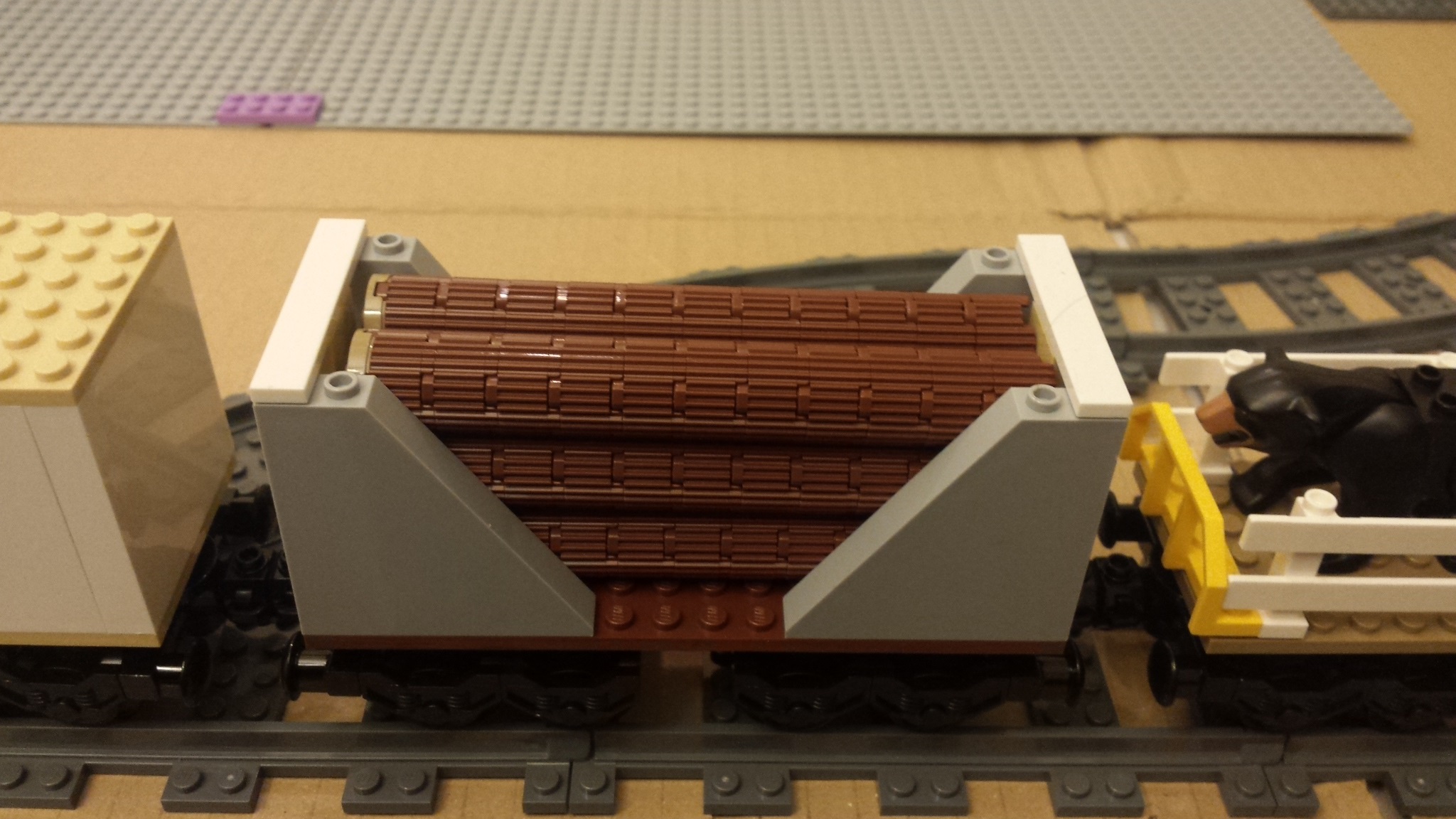
My first built freight train car is the logging car. It allows for transporting tree trunks between the forests and sawmills. This car holds 6 large trunks.
The middle sides of the
car are mostly open to
allow cranes to load or
unload the trunks. Note
also that each trunk has
a cut
end (with
a lighter color).
Refrigerated car:

A freight train may haul frozen or cold items. These are transported in refrigerated cars, which have an onboard cooling system and insulated walls.
The cooling system is normally powered by diesel fuel and often lasts for the duration of the transport time.
Trees car:
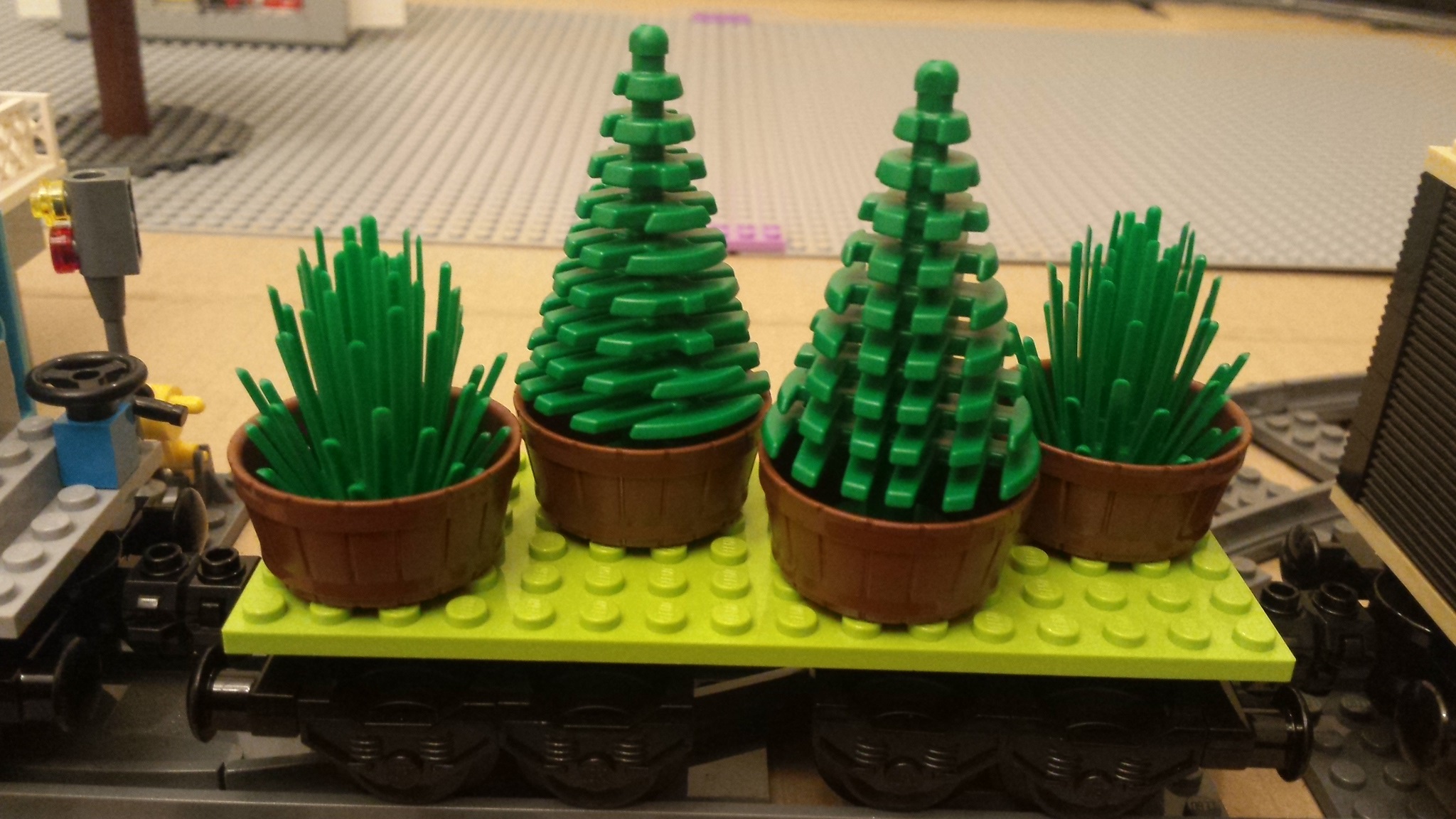
Big trees, bushes or other vegetation may be transported by rail. While smaller sized plants can be inside of a boxcar, larger ones would be on a flatcar.
My train is bringing in some Christmas trees and some bushes.
Water tank car:
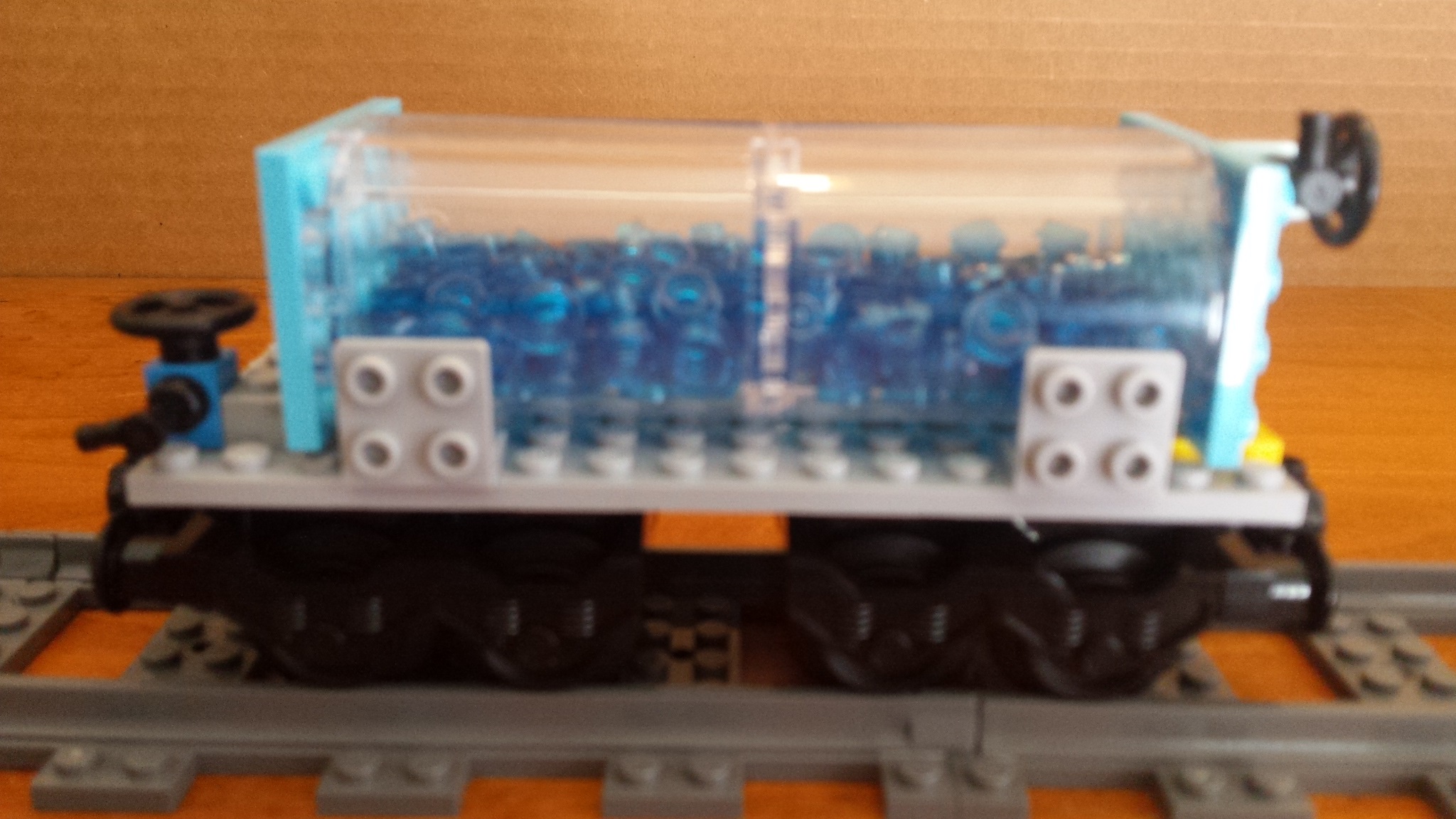
Tank cars usually have somewhat circular shaped long tank containers. These commonly transport liquids or gas. It is common to have a fill inlet near the top and a release outlet near the bottom.
My tank car could be used to transport water. I made it clear so that the amount of water inside could be easily viewed. Normally the tanks are not clear.
Additional cars:
Train museum:

The small museum track has
3 retired train cars. By
retired
I mean not
used in modern railways.
Left to right are the
handcar, coal car, and a
caboose.
The handcar is a manually
operated car which used
to be used to transport
workers or parts along
the tracks, usually when
no train was available.
Commonly a lever was used
by two (or more) operators
to provide the power
to move the handcar.
These would be used for
track repairs or getting
parts to trains with
mechanical problems.
In modern railways, a
motorized vehicle with
train wheels is used
instead of a manually
operated handcar.
The coal car used to be right behind a steam engine so that the coal could be easily moved to the firebox to produce the steam that the engine needed to operate. Modern engines run on diesel fuel that is stored in tanks on the engine itself.
Freight trains used to have a caboose as the last car on the train. The caboose was used to hold train crew, so it would have at least a table and seats. Some also had small kitchen, office, or washroom facilities. The crew in the caboose were responsible for watching the operations of the train and would notify the engineer of any problems so the train could be stopped.
Only a few modifications are planned at this time. The coal car will have small black pads for coal instead of the current 1x1 gray brick. It will also have an access port on a hinge and a shovel.
Coal car:
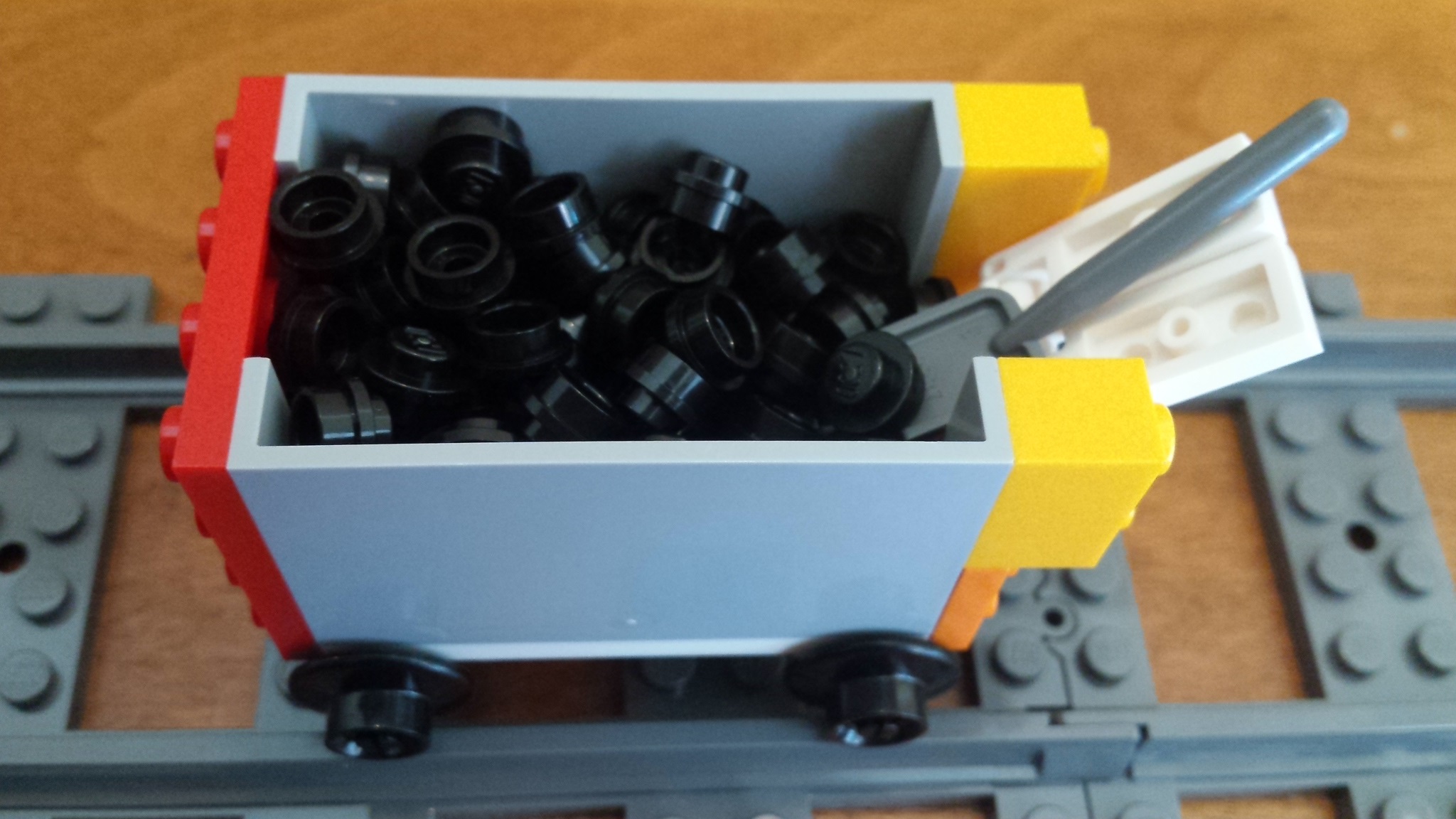
The coal in the coal car has been replaced. A hinged access port has also been added to allow the coal to be shoveled from this car into the engine.
The structures:
Crossing gates:

The crossing gates now
are more realistic.
The arms are manually
operated but really do
work like real ones.
These have the familiar
X
symbol as well
as simulated warning
lights.
Loading dock:
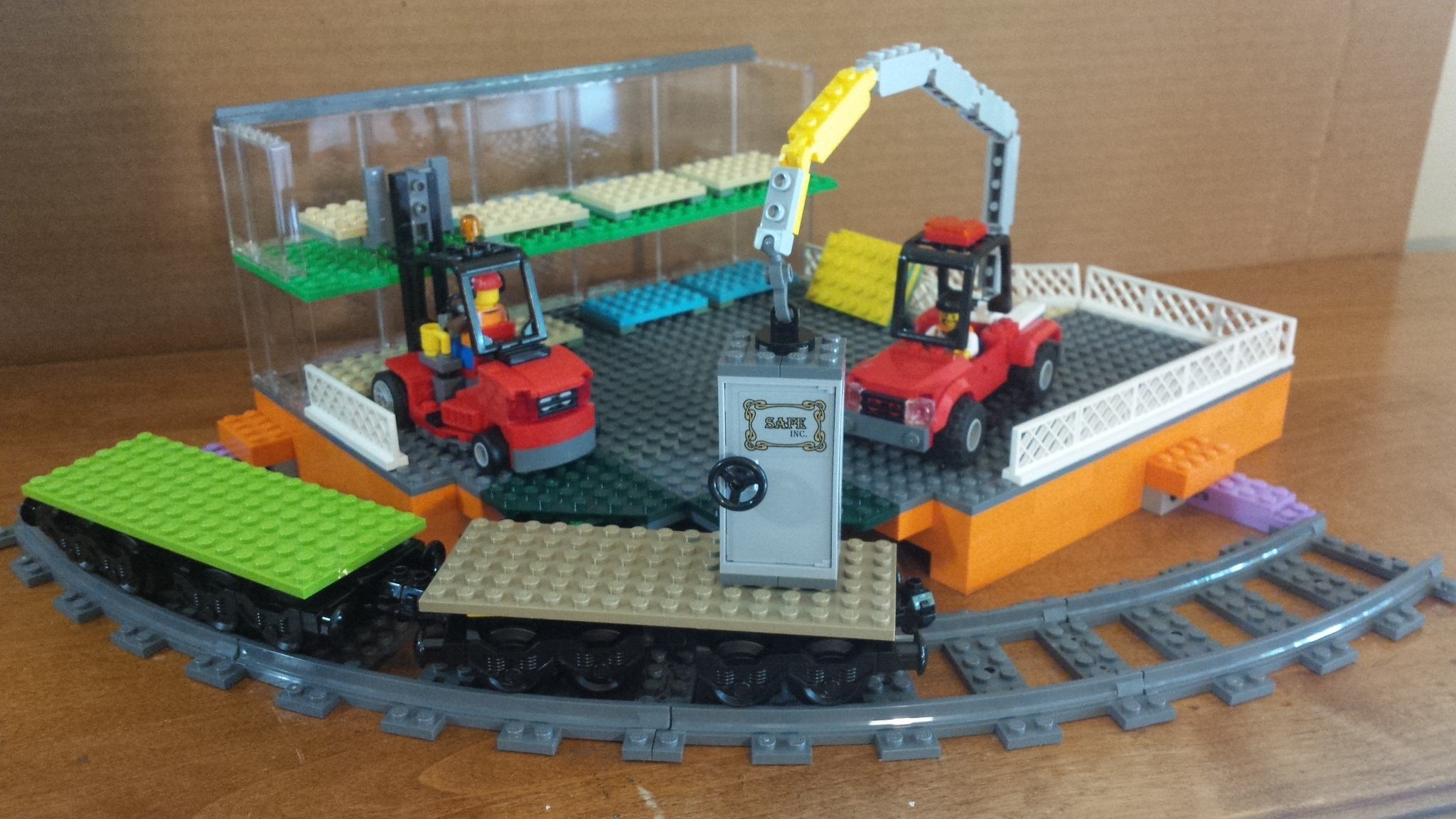
The loading dock is designed to be on a curve section of track because of the limited space I had for it. Even so, it seems to work well there. It is anchored to the track to prevent moving too close and causing a train to collide with it.
The dock has ample room for vehicles to move around on. The edge of the platform by the track is angled to match the position of a car being loaded. The height of the dock matches the bed of a freight train car and has a ramp for the vehicles to get back to ground level.
The dock has a bay to store pallets being transferred to a car. The bay could hold ten pallets, but with eight there is room to work with.
Two vehicles are used to transfer cargo; a forklift and a crane. The forklift normally moves pallets while a crane normally will lift cargo onto the car.
There is also a flatbed truck which is used to transport loads between the dock and their final destination.
Snack shop:

The snack shop is a place where people can get a quick bite to eat or drink. Just outside there is a table with condiments and two picnic tables.
The shop has shelves for snacks, a cooler/freezer for cold/frozen treats, a stove and oven for cooking, a sink. and a cash register. There is a menu board over the large front counter.
Washroom:
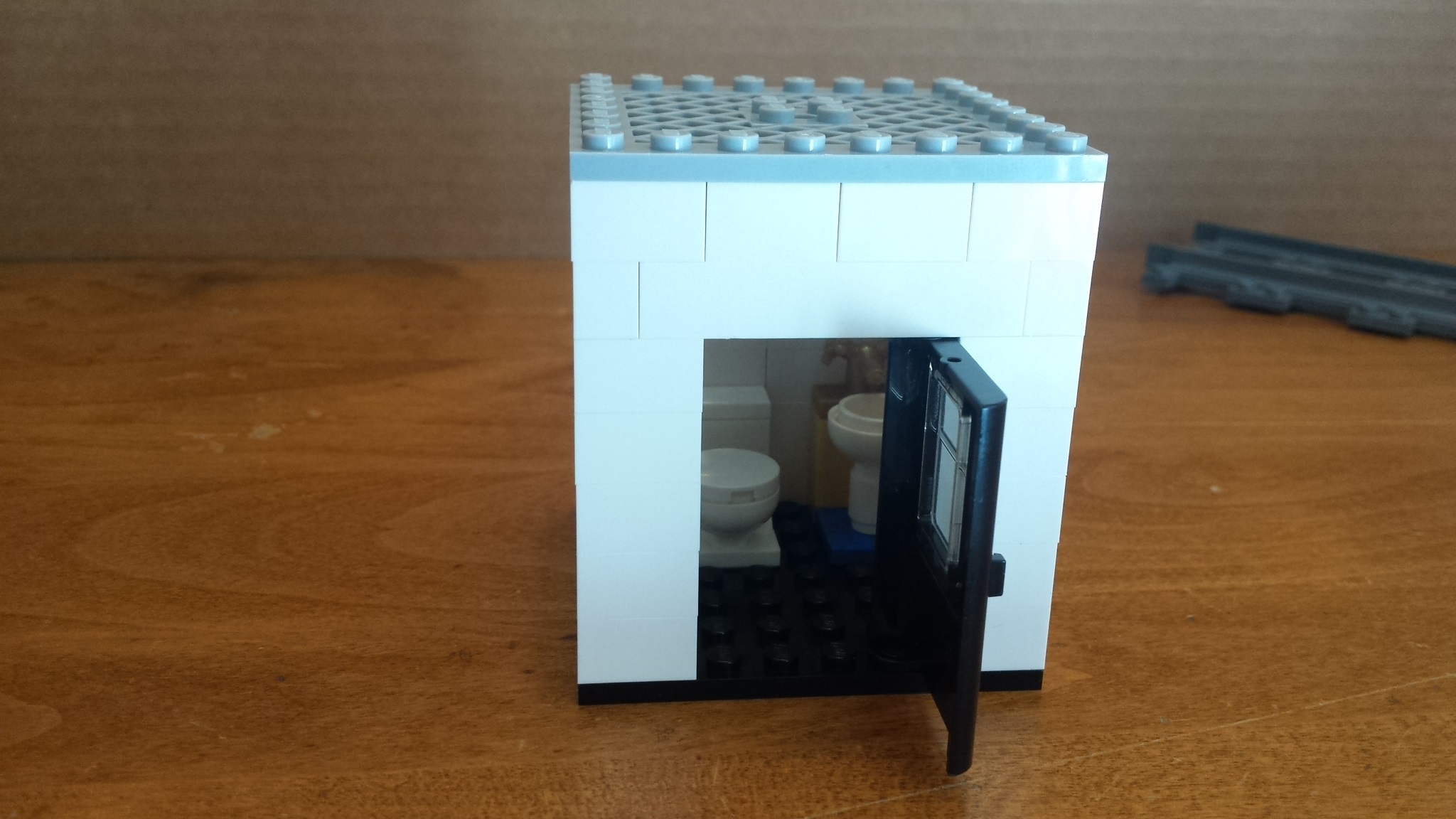
The simple washroom features a toilet and a sink. This one has a light, which is a Lego lightbrick that is manually operated by pushing a button (on outside rear wall).
Train station:
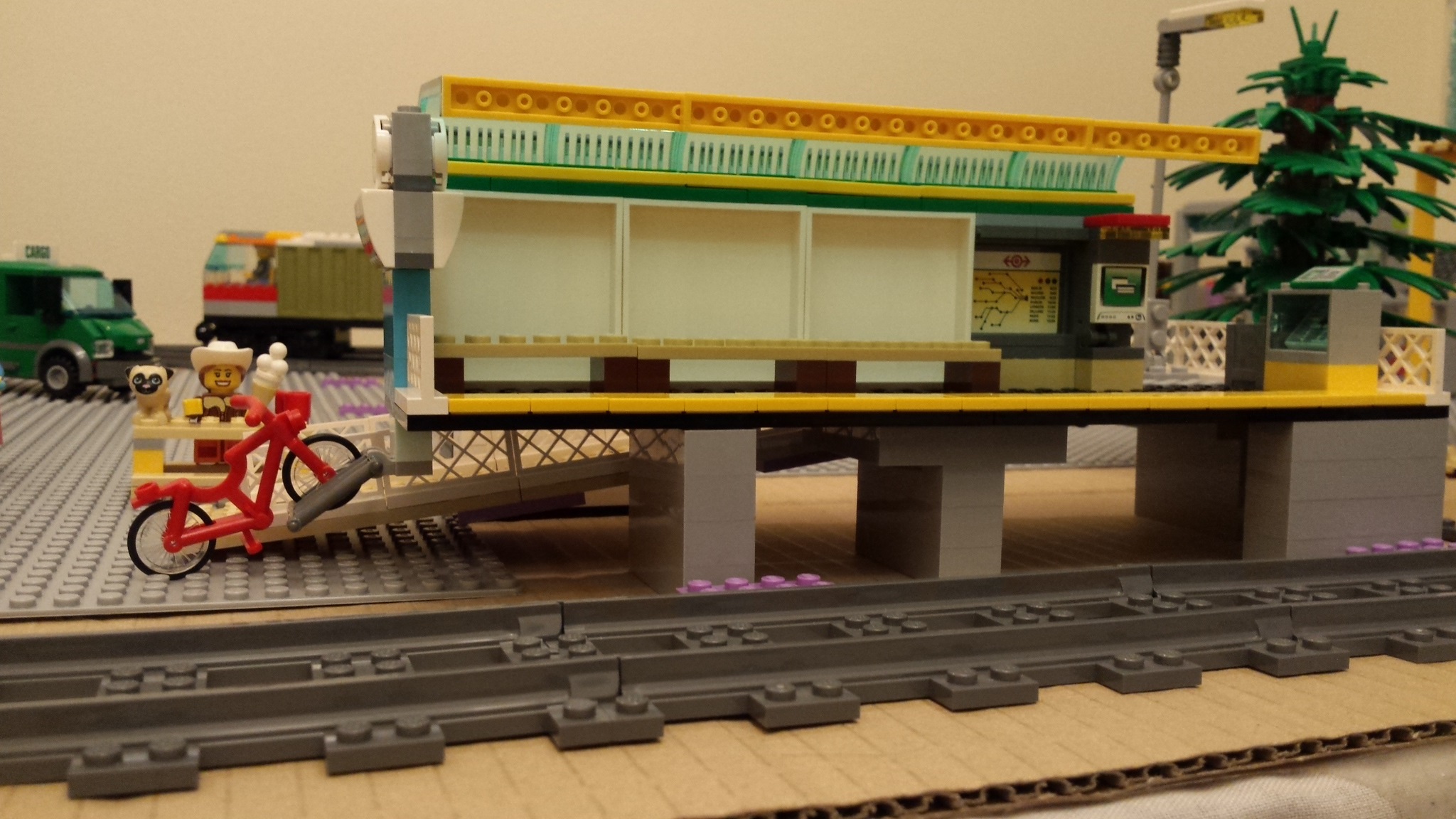
The passenger train station base matches the level of the passenger train car doors. The station has a ramp for entry from ground level to accomodate all passengers, including those in wheelchairs. The station has a covered platform to protect passengers from rain and snow with benches for several passengers. It also has a bicycle rack, trash bin, a train route map and schedule, a ticket machine, and a newspaper vending machine.
The foundation for the train station is not yet complete. I have one more possible addition to the station and will build the foundation once the rest is finished (so I do not have to rebuild it).
Train at station:
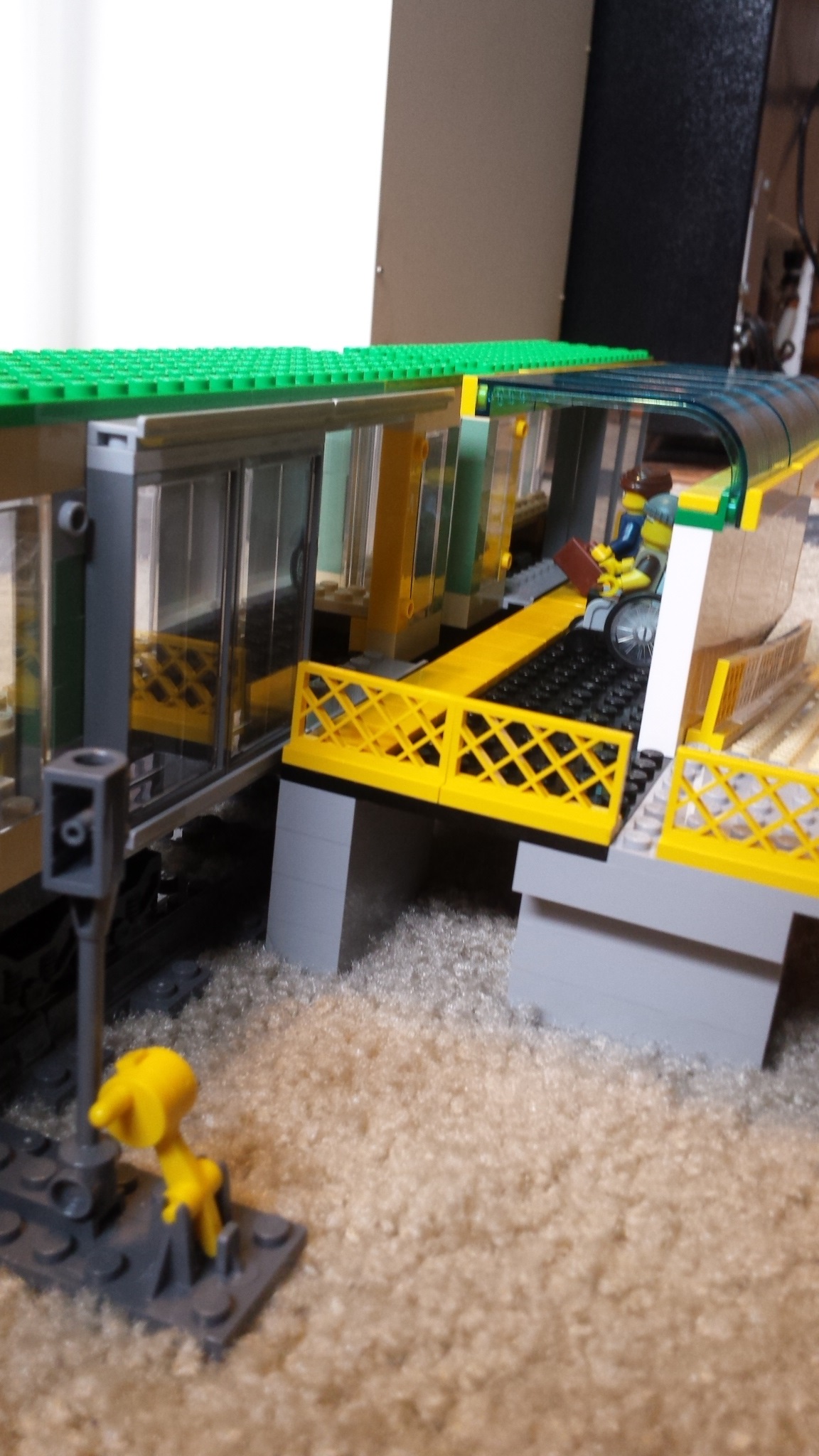
The passenger train station base matches the level of the passenger train car doors so it is easy to board the train.
Water tower:
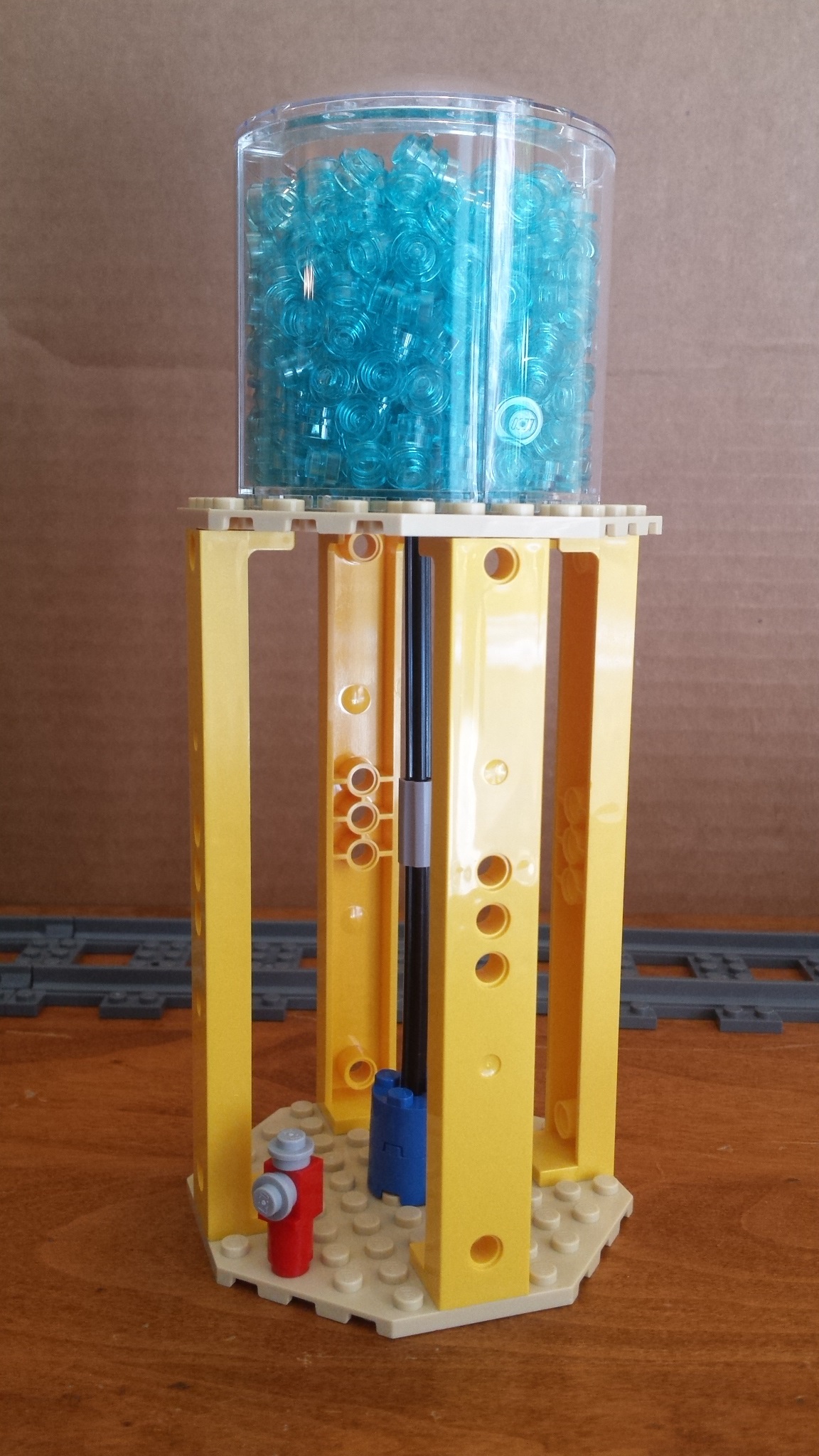
Railroad yards often have their own water tower, especially if it is in a rural area. Water is needed to provide for cleaning and restroom usage. Mine also has a fire hydrant to help fight fires which may occur.
Workshop/office:
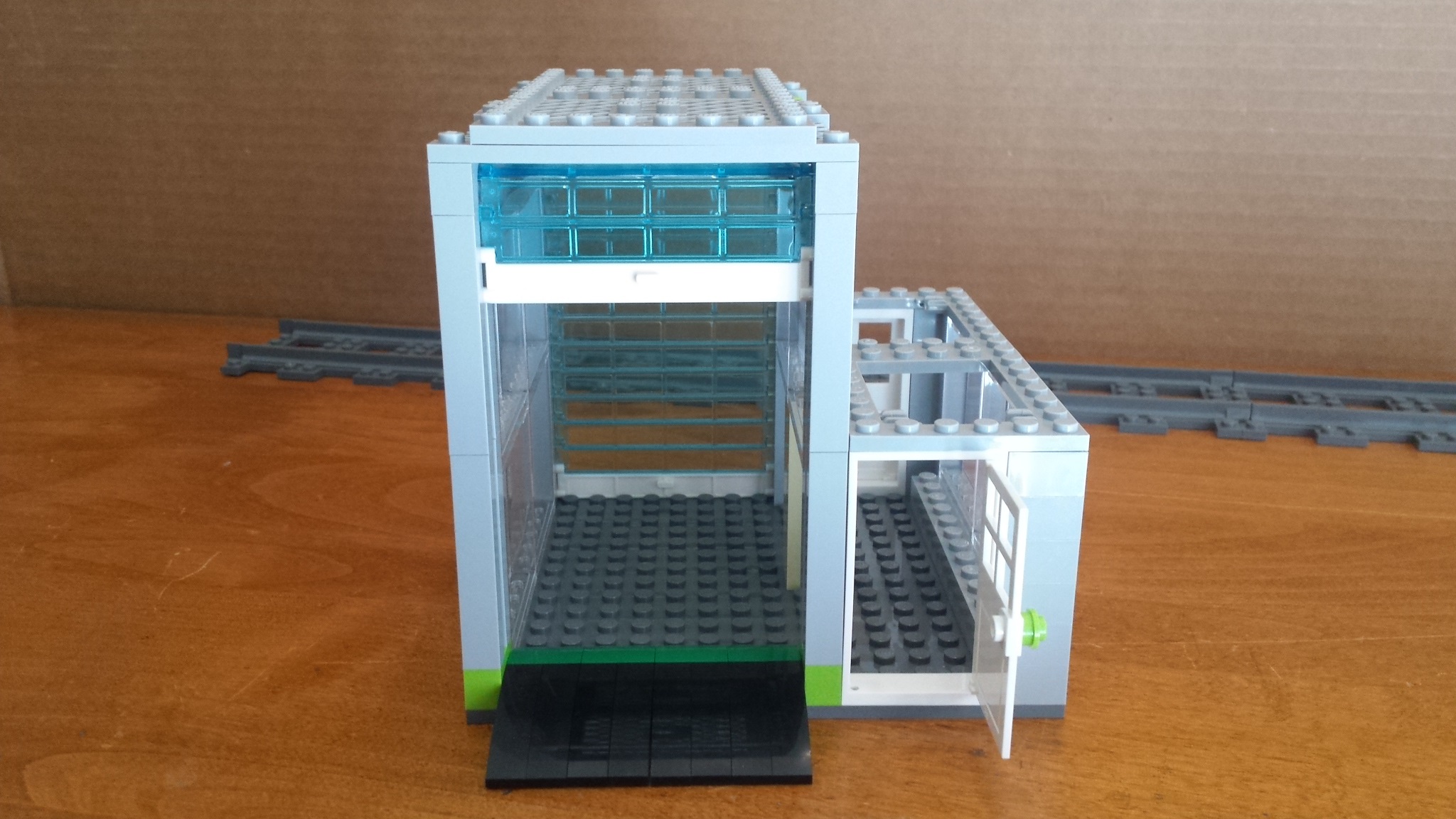
This building holds the office for the yard. It also has a large bay to repair or park vehicles. This is the structure only. Later the office area will have a desk, chairs, and accessories.
Note that BOTH the front and rear doors of the bay open. This allows the vehicles to drive through in one direction.

The building features many windows so that natural lighting is used. The office side will eventually have hinged windows as a roof which can be opened for additional light or temperature control.
The office portion has a desk. There is a computer, coffee machine, and a radio. Pizza is for lunch!
Shelter:
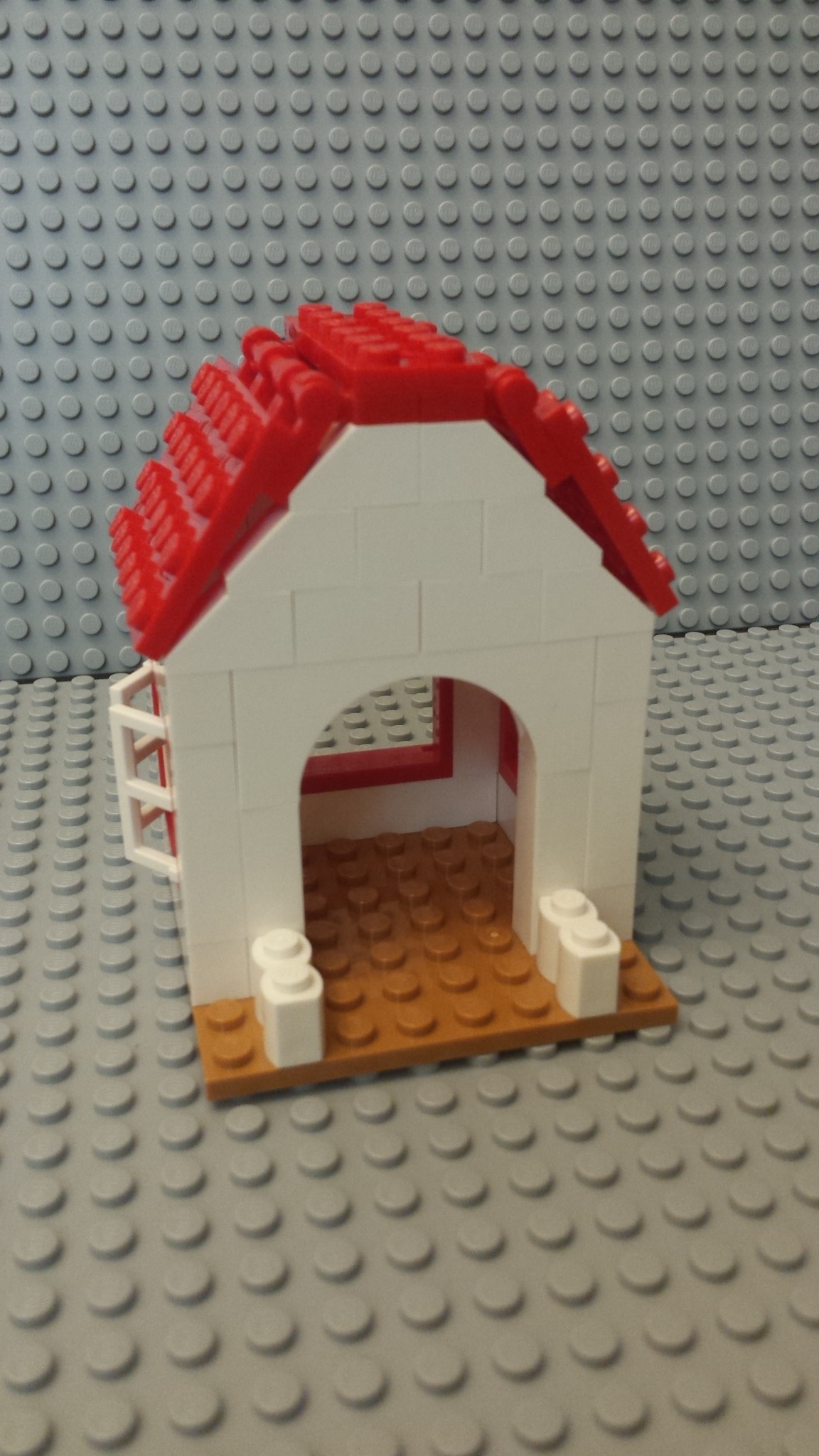
In the event of bad weather, visitors can take shelter in the shelter. This small building holds a few people. The roof also swings open if they want extra light on the pleasant days.
Control and security tower:
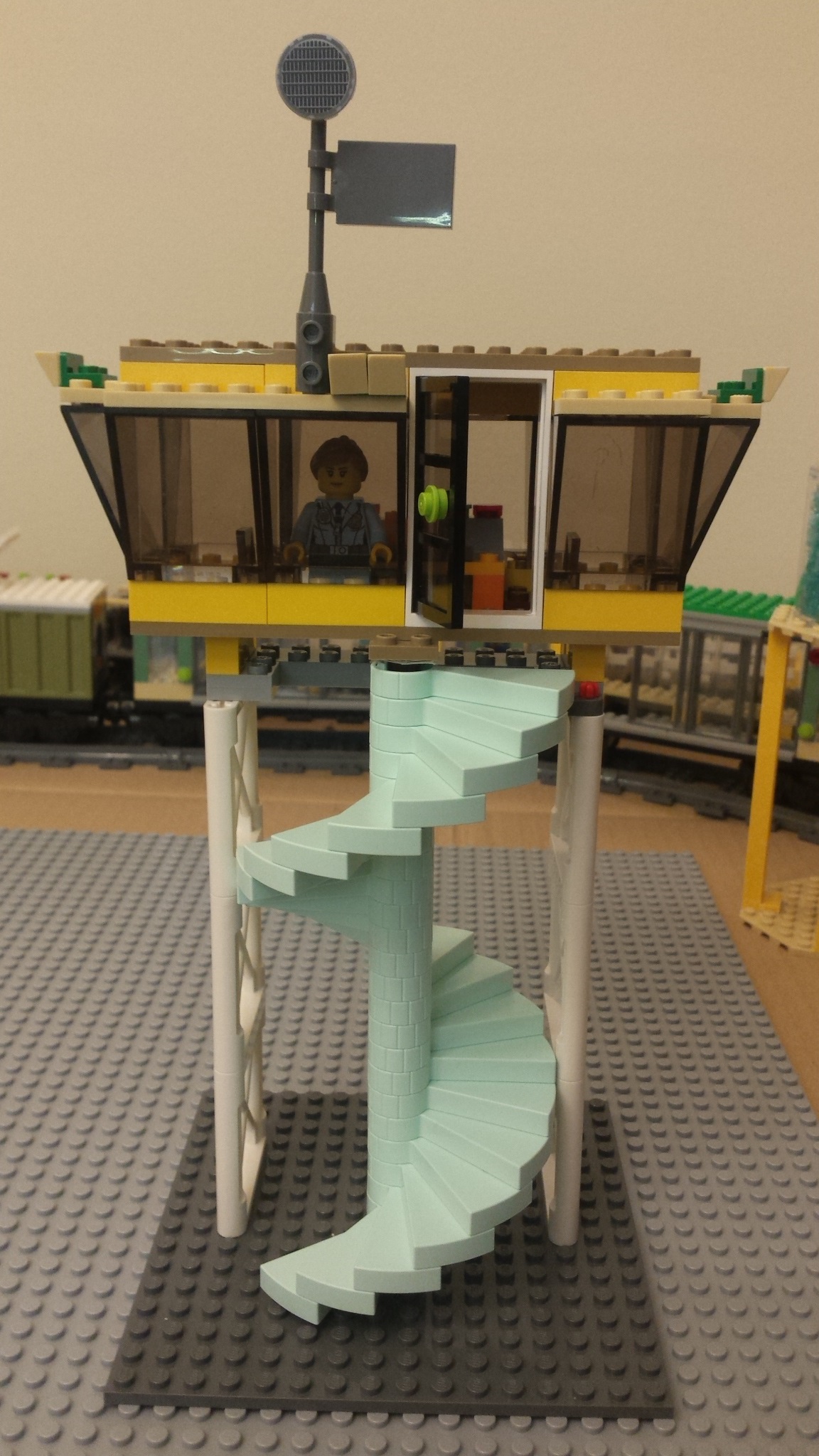
Towers such as this are used at some large rail yards. They provide a view of the entire yard for the staff. Train yard workers can use the tower to monitor the movement of trains. These workers can control the track switches to insure trains go to the right places.
Train yard security personnel use the tower to watch the area for any unwanted visitors. Modern day train yards also use cameras and sensors to assist the security staff.
My tower has a spiral staircase to get up there. The desk has the control panel for changing switches and communications with train engineers. The tower also has lights for the yard at night.
The Bailey Train Yard
and Golden Spike Tower
and Visitor Center
in
North Platte, Nebraska is
a large working rail yard.
Tourists can visit their
tower and learn about the
operations of the yard.
Their website also has a
live feed from a camera
overlooking the yard.
Bank, Laundry, and Apartment:
The train yard has a building to accomodate the needs of visitors. It has a bank, laundry mat, and an apartment. There are several real lights which help to illuminate the inside for better viewing.

The bank features a safe, teller table, a teller at the teller counter, a bank manager at his desk, and a table for customers. The bank is divided by a wall for security.
The laundry mat features five dryers with control panel, six washing machines with control panel, a large folding table, and seating area.
Between these is a revoling door which leads to the stairs for access to the apartment on the second level.
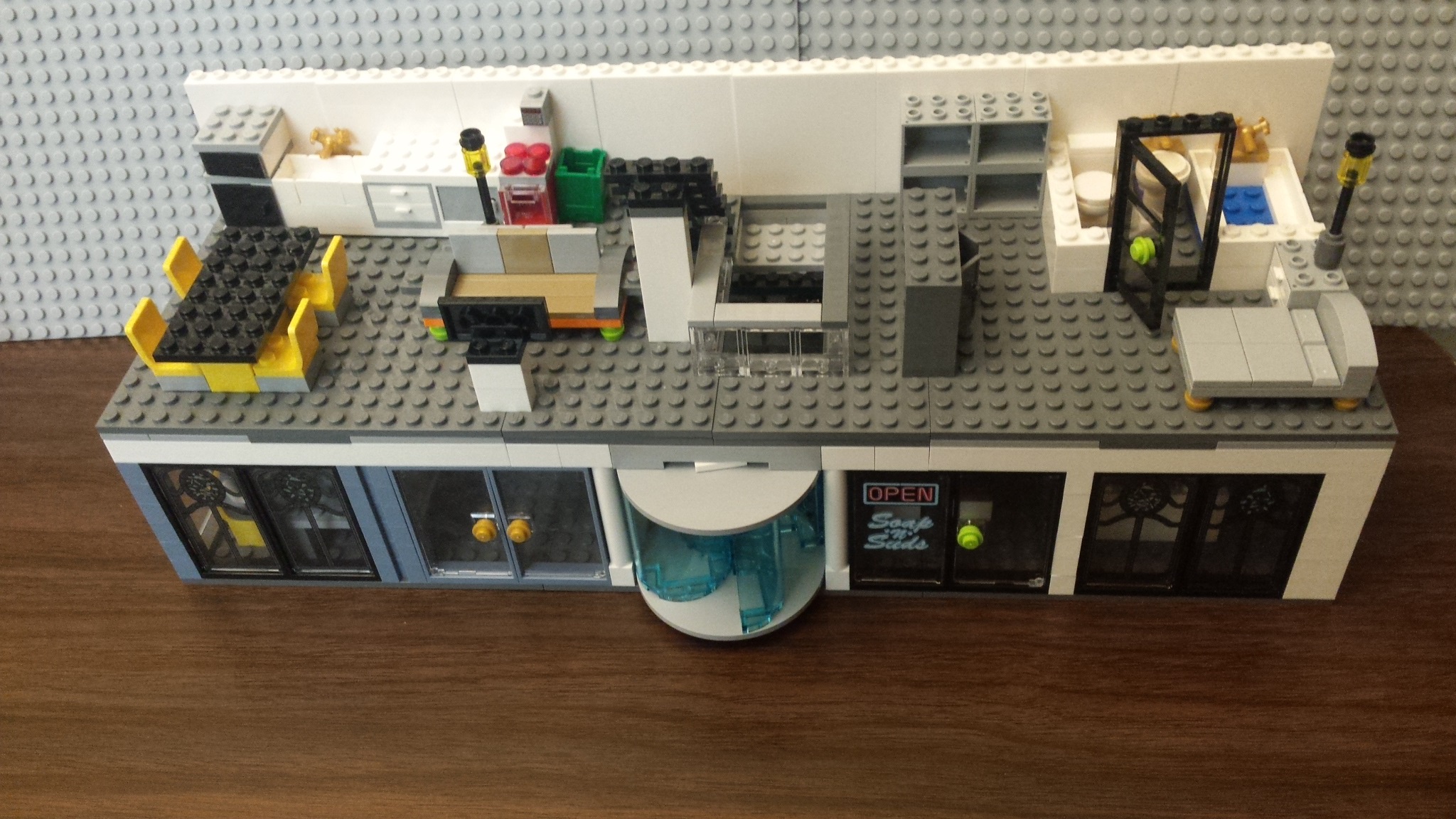
The apartment is shown without the front, side, and bathroom walls for a better view of the layout. The photo of the roof shows the front of the building in place.
The apartment has an open layout with few walls. It features many items found in living quarters. The kitchen has an oven with stovetop, a countertop, a large sink, and a refrigerator, The dining room table seats four people. The large couch has a light at the back and cup holders on each side. The TV is in front of the couch.
There is storage room in the form of shelves and a dresser. The full bathroom features a toilet, sink, and tub. The nightstand has a light and drawers. The bed is very comfortable.
In the middle are the stairs. One leads to the ground level entry and the other to the roof.
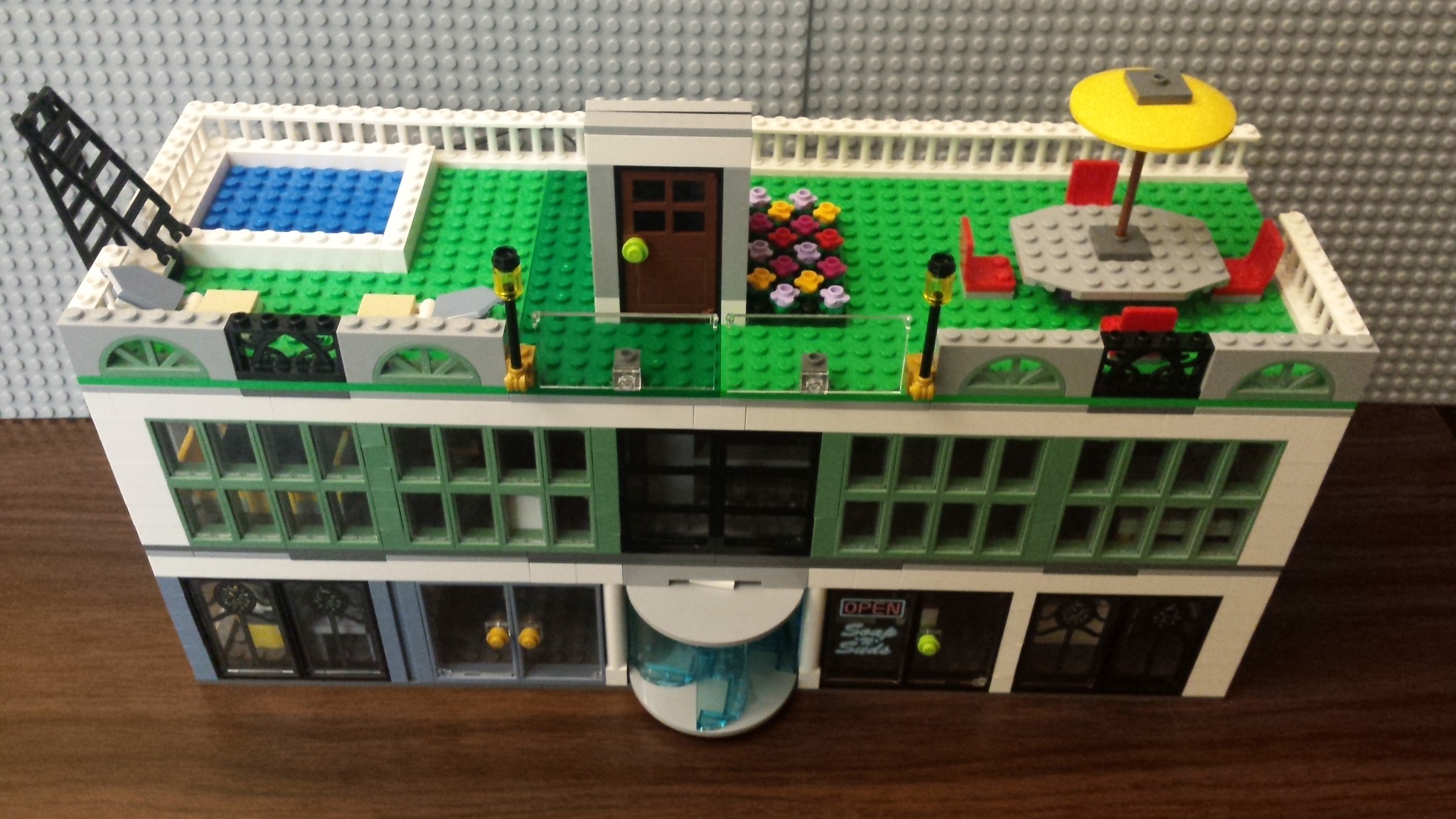
The roof of the building features many items often found in yards. There is a swimming pool, fire escape ladder, lounge chairs, a garden, and a patio table set.
There is access to the main building through the door leading to the stairway. At the right, there will be a bridge to the mid level of the hill and tunnel.
Park:

The Park At The Yard
will have a seating area,
grassy play area, and a
large tree which has a
tire swing and ladder.
Today Santa is visiting the park in a horse drawn wagon. He has a few gifts to hand out.
Tunnel:
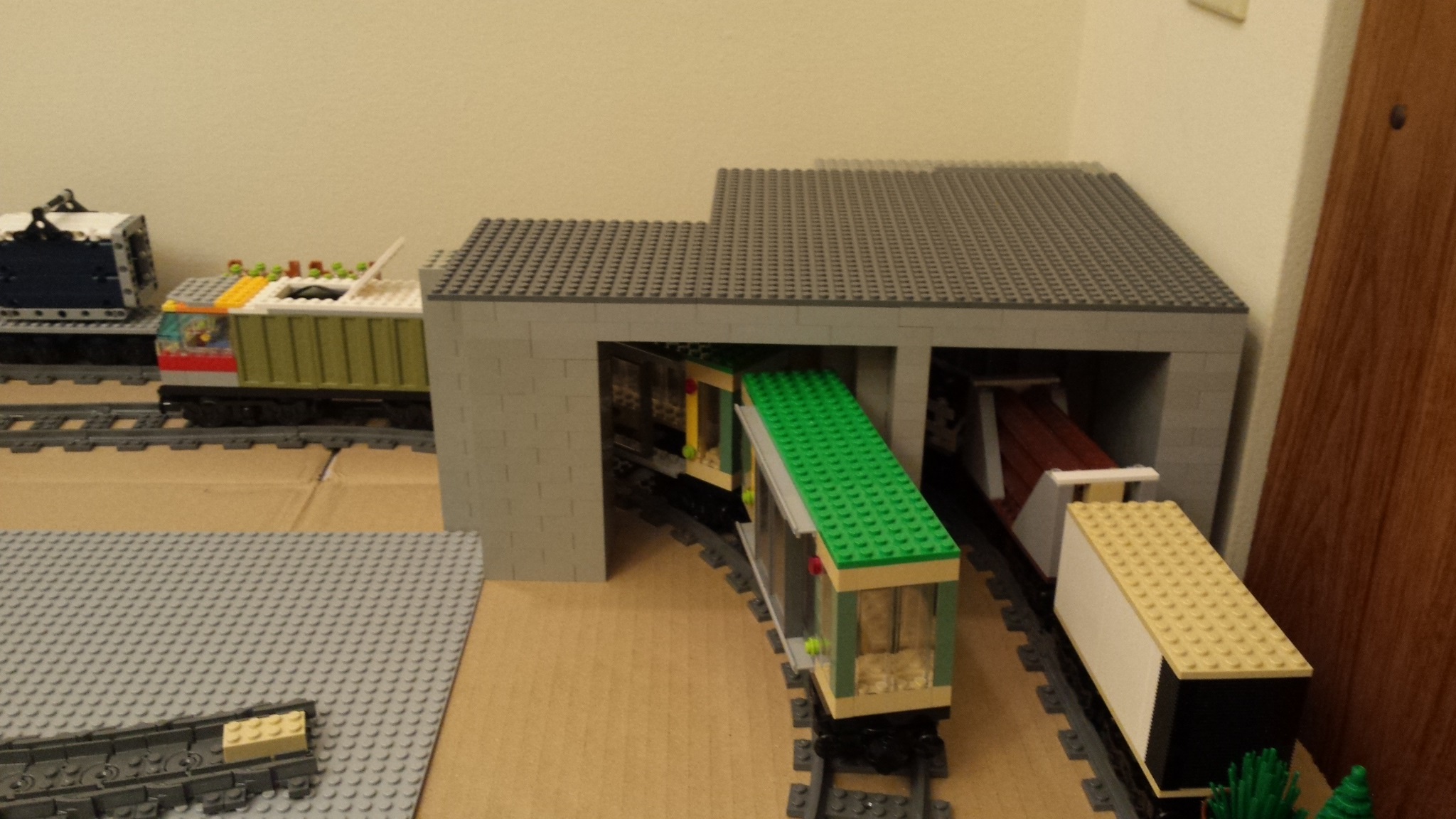
Sometimes trains go through tunnels so I created one for my display. Although this is a small tunnel, it still works for the layout. The design was a bit tricky as the two tracks have different curve patterns.
The plan is to put the aquaium on top of the tunnel. There may also be room for something else there. At the back will be the remainder of the hill.
.....Project completed!
Page last updated: November 09 2018 07:44:11.
Page visited: 1524
